

Most Common Travel Trailer Ball Hitch Size

Sharing is caring!
Thanks for your support! If you make a purchase using our links in this article, we may make a commission. And, as an Amazon Associate, I earn from qualifying purchases. See the full disclosure here .
Updated April 13, 2024
Your travel trailer ball hitch is an essential part of your towing setup. Without it, your trailer isn’t going anywhere. But things can get a little confusing. Why are there four different sizes for travel trailer ball hitches?
How do you know which one is right for you? How do you know you’re using travel trailer ball hitches correctly? We’ll let you know.
Thankfully, it’s not as complicated as it seems. Let’s take a look at the different sizes of ball hitch for travel trailers. Plus, we’ll look at some tips for using your travel trailer ball hitch and of course some of the best brands to buy.
How Do I Know What Size Hitch Ball I Need?
One of the first places to look for the right size hitch ball is on the side of the coupler at the front of the RV. If it’s worn off or rusted and you can’t read the hitch ball size requirement, your next destination is the RV’s manufacturer’s manual.
The most common Hitch ball size for a travel trailer is 2”, though 2 and 5/16” and 1 and ⅞” are also fairly common.
The 4 Most Common Travel Trailer Ball Hitch Sizes?
The most common travel trailer ball hitch sizes are:
- 1-7/8 inch hitch balls are for lightweight towing under 3,500 lbs. Some smaller trailers, particularly older pop-up campers, might use this ball. But otherwise, this size can’t handle enough weight for most RV towing.
- 2-inch hitch balls are for medium-weight towing, with weight ratings up to 12,000 lbs. available.
- 2-5/16 inch hitch balls are for heavyweight towing and can have ratings up to 20,000 lbs. (or slightly more). Because they handle more weight, these are the travel trailer hitch ball sizes you’ll see for most towable RVs.
- 3-inch hitch balls are only used for gooseneck towing. This type of towing hitch isn’t typically used for hauling fifth-wheel RVs.
For most RVers, the standard travel trailer hitch ball size will be 2” or 2-5/16”. Smaller travel trailers will usually use a 2” ball, while heavier trailers will need the 2-5/16” ball.
Besides the diameter of the hitch ball, there are some other measurements you’ll see. Two measurements are the length and diameter of the “shank” – the threaded stem below the ball. There’s also the rise, which is the height the ball sits off its base.
6 Tips For Using Your Travel Trailer Ball Hitch
When you use your travel trailer ball and hitch, there are a few things you should keep in mind for the best experience. Following these tips will keep you safe and help keep your trailer in good condition.
1. Watch Your Weight
It’s incredibly important to never exceed your towing system’s weight capacity. Going over by even a couple pounds can be incredibly unsafe.
The weight limit of your trailer ball is also known as the ball capacity. This number is usually found on the top of the hitch ball or at the base of the shank.
Keep in mind that your hitch ball isn’t the only part of your towing system. Your hitch and your RV trailer hitch ball mount also have their own weight limits.
The weight limit for your hitch will be on a label somewhere on the hitch. The ball mount’s limit will usually be on a label on the front or along the shaft that slides into the receiver.
Your max weight limit is only as high as the lowest limit for all three. So if your hitch is rated for 10,000 lbs, your ball is rated for 8,000 lbs, and your mount is rated for 6,000 lbs, your towing limit is 6,000 lbs.
2. Use Lubricant
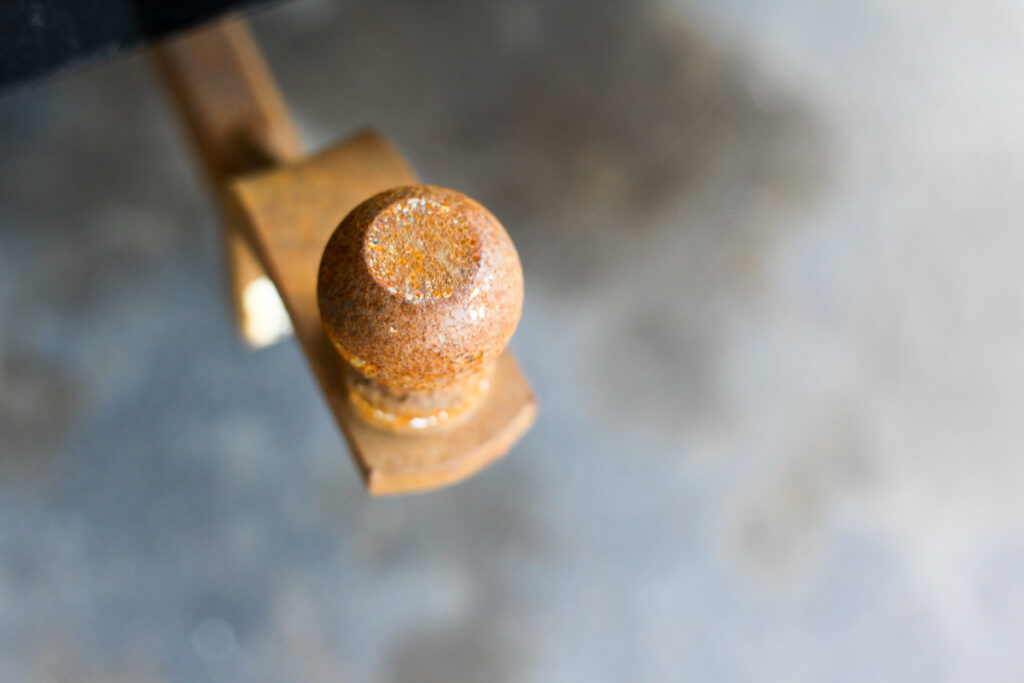
You can use your travel trailer ball hitch without lubricating it first, but lubrication is highly recommended . Lubrication ensures structural integrity and prevents noise, but it also keeps your ball from getting rusty.
You should grease your hitch ball at least twice a year. If you’re keen to keep it performing at its best, it’s recommended that you apply some lubricant before leaving on a trip. When you put on a new coat, make sure you wipe off the old one first.
3. Use a Hitch Pin Lock
You’d think that nobody would try and steal something as big as a travel trailer , but sadly, you’d be wrong.
A travel trailer is no small investment, not to mention that if it gets stolen mid-trip, you’re out of a place to sleep. So to keep someone from driving off with your home on wheels, it’s smart to use a hitch pin lock to keep your trailer safe .
A hitch pin lock will keep anyone from disconnecting your trailer from the trailer hitch or from connecting it to their vehicle when you’re not using it. There are two different kinds: receiver-style and coupler-style.
A receiver hitch lock is a metal pin with a lock on one or both ends. It protects your trailer when it’s hitched up to your vehicle. However, it won’t help you when the trailer isn’t attached.
Coupler hitch locks protect your trailer even when it’s not attached to your tow vehicle. They’re like a big U-lock for your hitch. Without the proper key, connecting a trailer is impossible.
4. Use a Weight Distribution Hitch
A weight distribution hitch is often recommended when towing a travel trailer. These hitches help distribute the trailer’s weight evenly.
With improperly distributed weight, most of the force is borne on your tow vehicle’s rear axle. This has a hugely negative impact on steering, traction, and your ability to stop. Or, you can also have the opposite problem. If you have too little tongue weight, your trailer will become more prone to sway.
A weight distribution hitch uses a pair of spring bars that go from your flat-tow vehicle to the trailer. These springs apply leverage to spread the load out evenly onto your vehicle’s front axle and your trailer’s rear axle. This will give you a stable, level, and smooth ride also preventing your vehicle from sagging.
Not all weight distribution hitches have sway control, but if your hitch does, it will also avoid a lot of sway.
There are some minor downsides to weight distribution hitches, including harder turns and more time spent hitching and unhitching. However, it’s a good idea to use one for larger loads and heavier trailers. If you’re unsure if you need one, check your tow vehicle’s manual for guidance.
5. Keep Everything Level
It’s absolutely essential that your travel trailer and tow vehicle be level with the ground.
However, most vehicles and trailers won’t line up perfectly. The difference in height is referred to as the “rise” or the “drop” – depending on whether the camper trailer ball hitch is higher or lower than the coupler.
Can A Trailer Hitch Ball Break Off While Driving?
Anything is possible, though it takes some torque or a previously compromised hitch ball to happen. Most of the time, when trailers come uncoupled from the towing vehicle, it’s because of a failure in the connection somewhere along the line, rather than the hitch ball snapping clean off.
The kind of sudden torque that will snap a hitch ball is only supposed to happen in the event of the RV flipping, so it doesn’t flip the towing vehicle with it. For the same reason, you’re not supposed to use the hitch ball for recovery. In other words, don’t attach something to the hitch ball to pull a car out of a ditch, or something similar.
A hitch ball is designed for security, not for the pulling and pushing forces of a recovery, or the sudden twisting of a coupled trailer.
How to Calculate the Rise or Drop for Your Ball Mount
To calculate the rise or drop of your ball mount, measure the distance between your trailer’s coupler and the ground to get your coupler height. Then, measure the distance between your hitch receiver to the ground to get your hitch height.
Subtract your coupler height from your hitch height and you’ll have your rise or drop. A positive number means a drop and a negative number means a rise.
For example, if you have a 17” hitch height and a 13” coupler height, you need a 4” drop. For the same coupler on a 12” hitch, you would need a 1” rise.
You’ll need an RV trailer hitch ball mount that fits this number. Many ball mounts can be installed in either direction to give a drop or a rise. Adjustable travel trailer ball hitch mounts can also be set at whatever height you need.
6. Always Match Your Hitch Ball and Coupler Sizes
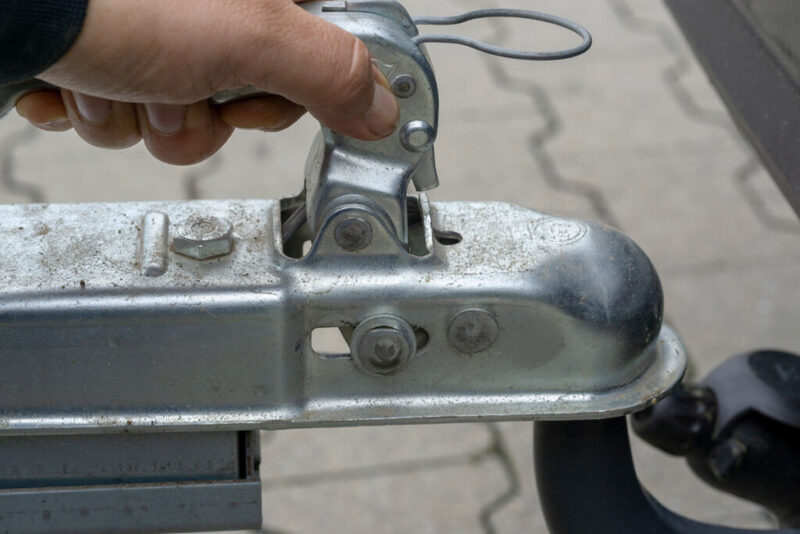
Your RV trailer hitch ball size doesn’t mean a thing if it doesn’t match your trailer’s coupler. The coupler is the part of the trailer that connects to the hitch ball. It slides over the ball and is clamped shut to provide a sturdy hold that can still move with you on the road.
The differences between travel trailer hitch ball sizes don’t seem too major. Couldn’t you just use a 2-5/16” coupler on a 2” ball?
The answer is absolutely not ! Even that small difference can lead to your trailer detaching from your vehicle. That can result in a damaged trailer and can also put other people in danger.
Always ensure your coupler and camper trailer ball hitch are the same sizes. Doing otherwise is a recipe for disaster.
What are the Advantages of Using Adjustable Travel Trailer Ball Hitches?
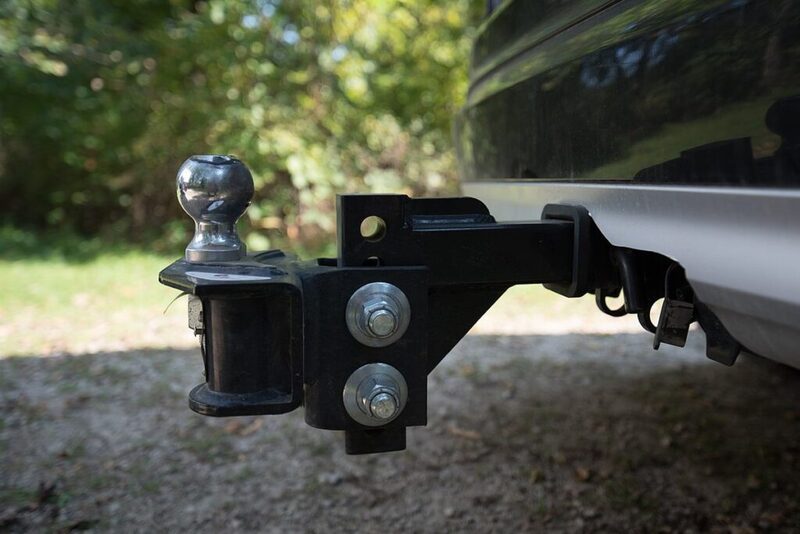
Your hitch ball and your RV trailer ball mount can both be adjustable in different ways.
Adjustable drop ball mounts let you change the height of the ball mount to meet the rise or drop required for your trailer to be level. This precision and control let you get everything perfectly level.
There are also different kinds of ball hitches for travel trailers that can be adjusted in various ways.
A switch trailer ball is basically a trailer ball shank with a removable head. You switch out the different sizes of balls as you need them.
There are also double – or even triple-sided hitch balls. These have different sizes of hitch balls on a single mount. Simply rotate to the ball you need for any given circumstance.
If you only expect to tow the same trailer all the time, these different hitch balls might not be of much use to you. But if you tow other things besides your travel trailer, they can really come in handy.
The Best 5 Brands of Travel Trailer Ball Hitches
Now that you know all about ball hitches, let’s look at some options for the best ball hitch for a travel trailer.
1. Equal-i-zer
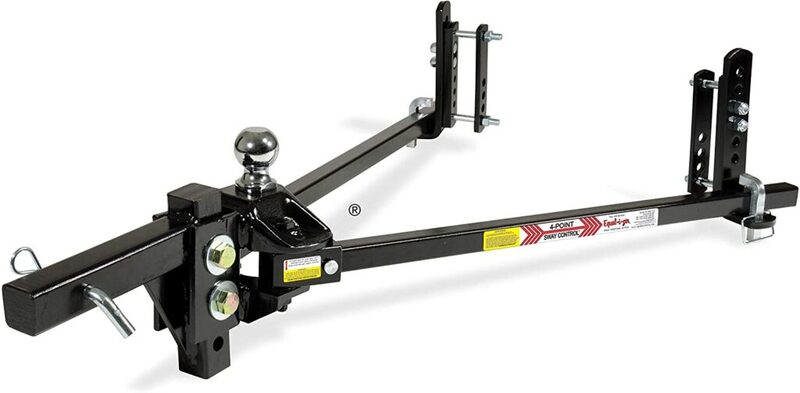
Equal-i-zer weight distribution hitch is one of the most popular brands of trailer hitches with 75 years of history. They were also the brand that created the first sway control hitch.
These hitches provide even weight distribution and their special “4-point sway control” to eliminate trailer sway. Plus, Equal-i-zers are 100% American-made using high-quality American steel and include a lifetime warranty.
The heavy-duty model is rated up to 16,000 pounds and has a great weight distribution system. The company recommends a 2 5/16 ball for the best pairing.
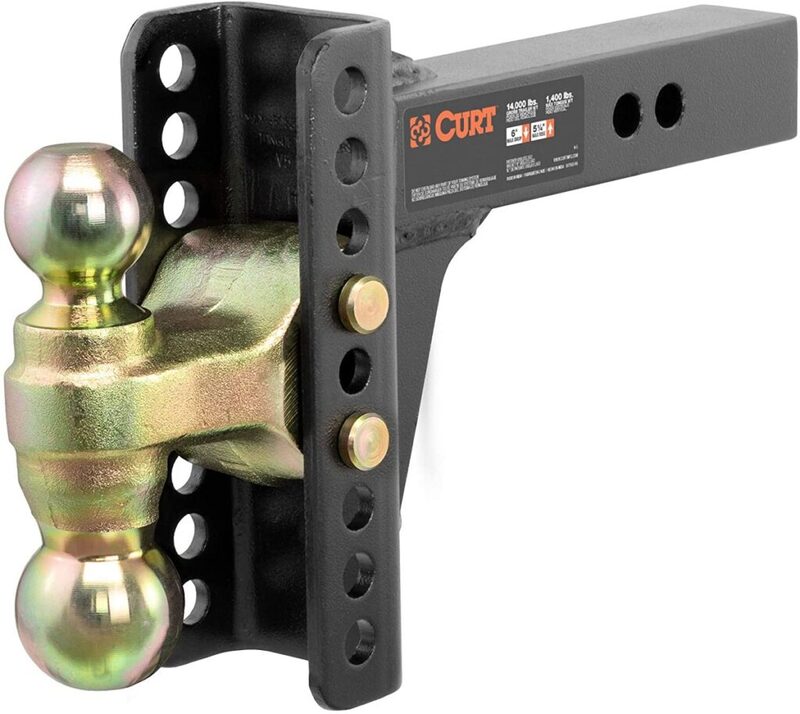
CURT Manufacturing Adjustable Travel Trailer Ball Hitch Mount is an industry leader in manufacturing USA-made trailer hitches. They offer a huge array of hitches for any need and are all rigorously safety tested to give you peace of mind.
CURT has any kind of hitch you could need including weight distribution hitches. If you need any accessories, like hitch locks or wheel chocks (if this is your first RV, you definitely need these), they’ve got you covered there too.
This particular model comes with a 2-inch and 2 5/16-inch ball hitch. It’s rated at 14,000 pounds and can provide a 6-inch drop.
3. Weigh-Safe
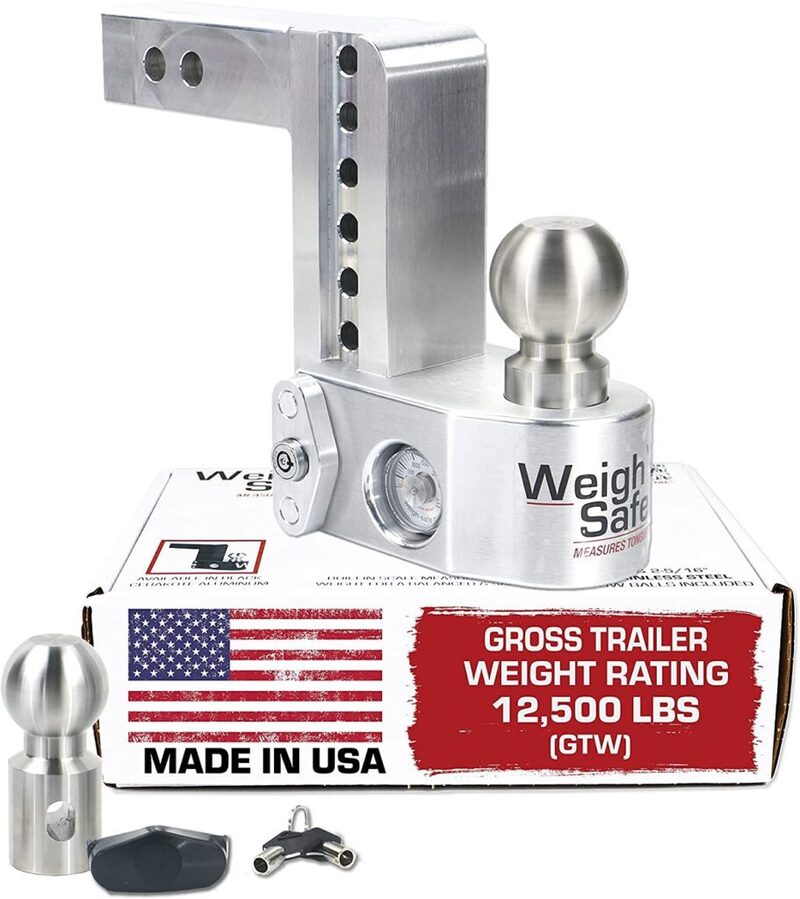
Worried about your weight? A Weigh-Safe adjustable travel trailer ball hitch mount can give you some peace of mind.
Weigh-Safe’s claim to fame is that their hitches are the only ones on the planet with a built-in scale. This measures the tongue weight of your tow load, helping you balance your load and improve performance. Plus, Weigh-Safe makes all their products from high-quality materials to the highest specifications.
4. Reese Towpower
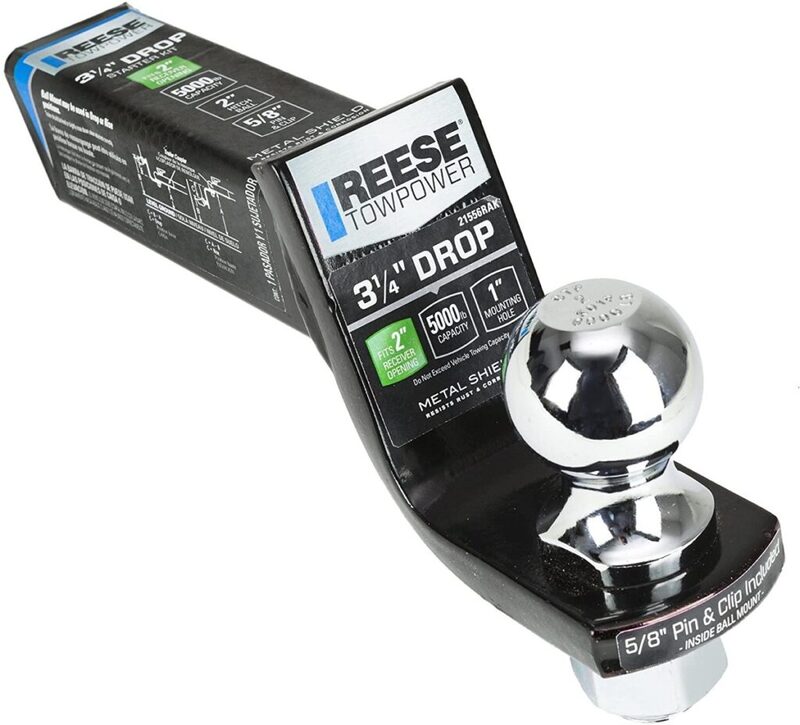
Reese Towpower is a big name in towing that has been around since 1952.
RVers might know Reese Towpower best for their heavy-duty fifth-wheel hitches, which are a popular choice for you guessed it – fifth-wheel trailers. But they also carry just about any towing product you need, and it’s all covered by a 1-year warranty!
Take a look at their starter kit with a 3-¼” drop mount and a 2” hitch ball rated for up to 5,000 lbs.
5. Draw-Tite
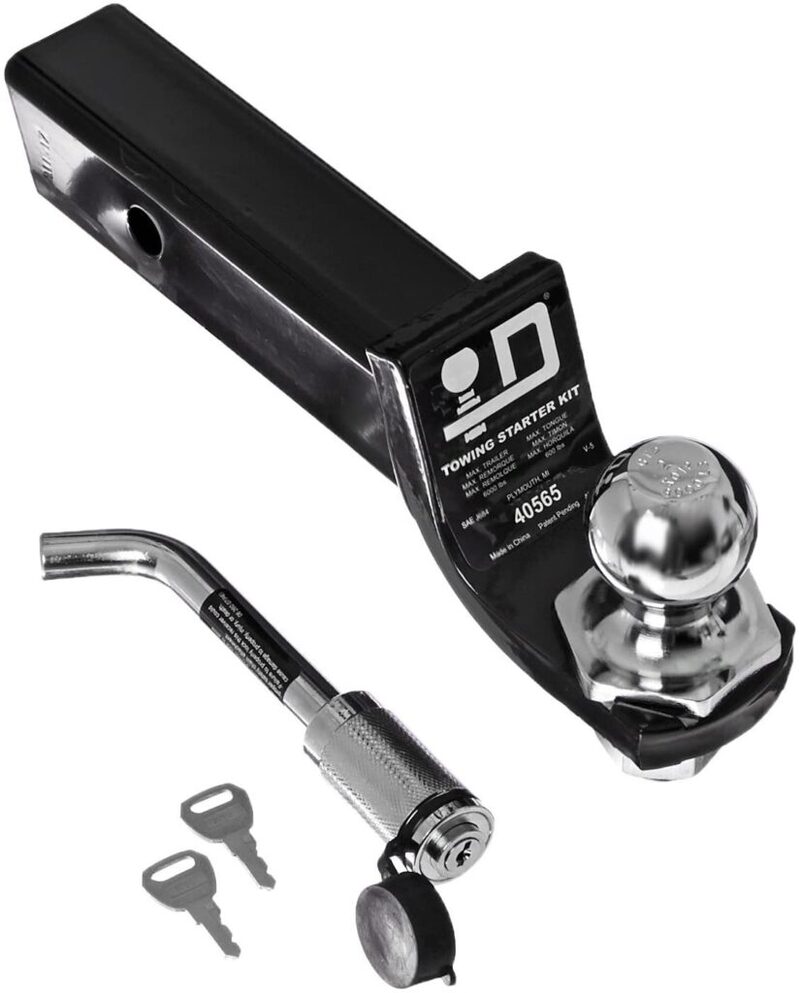
Draw-Tite produces top-quality, rigorously tested trailer hitches and they’ve been doing it since 1946. This makes them one of the most trusted brands for travel trailer ball hitches. Every Draw-Tite hitch is also backed by a lifetime warranty.
Consider their starter kit with a 2” drop mount and a 2” hitch ball included, as well as a receiver lock.
Are Trailer Chains Required By Law?
Most states require safety chains on a traditional hitch and tow operation. The same is not true of fifth-wheels, though they are fundamentally different on every level and don’t need chains as a backup safety measure.
The purpose of the chains on a hitch and ball setup is self-evident. In a case where the coupler comes loose from the ball, the chains act as a safety catch. They aren’t designed to continue towing the trailer, but only to keep an unmitigated disaster from occurring in the case of decoupling.
Final Words About Travel Trailer Ball Hitch Size
Your travel trailer ball hitch is one of the most important parts of your whole towing system. One little ball is where your trailer attaches to your vehicle, so it’s important to have the right one.
For the majority of RVers towing a travel trailer, the suitable trailer hitch ball size is going to be 2″ or 2-5/16”. No matter what size you’re towing, it’s critical to ensure your setup is correct and calibrated for your rig. What your buddy is doing may not be exactly right for you.
Now you know everything you need to know about travel trailer ball hitch sizes, it’s time to hitch up and hit the road!
Related Reading:
– Should I Grease My Trailer Hitch Ball or Not? – 35 Biggest RV Beginner Mistakes to Avoid! – RV Hookups Explained (Water, Sewer, Electric) – How To Stop Travel Trailer Sway
Mike Scarpignato – Bio
Mike Scarpignato created RVBlogger.com over five years ago in 2018 to share all we have learned about RV camping.
Mike is an avid outdoorsman with decades of experience tent camping and traveling in his 2008 Gulf Stream Conquest Class C RV and 2021 Thor Challenger Class A motorhome.
We attend RV Shows and visit RV dealerships all across the country to tour and review drivable motorhomes and towable trailers to provide the best evaluations of these RVs in our blog articles and YouTube videos.
We are 3/4-time RVers who created RVBlogger.com to provide helpful information about all kinds of RVs and related products, gear, camping memberships, tips, hacks and advice.

Leave a Comment Cancel reply
Save my name, email, and website in this browser for the next time I comment.
JavaScript seems to be disabled in your browser. For the best experience on our site, be sure to turn on Javascript in your browser.
- My Purchase Orders
- Compare Products

Standard Trailer Hitch Ball Sizes | How to Choose

In this guide, we will cover how to measure a trailer ball, what size trailer ball to select for your vehicle and what the most common trailer ball size is.
4 Standard Trailer Ball Sizes:

1-7/8-inch diameter
Light-duty towing

2-inch diameter
Medium-duty towing

2-5/16-inch diameter
Heavy-duty towing

3-inch diameter
Gooseneck towing
How to Choose a Trailer Ball Video
What Size Trailer Ball Do I Need?
The size of the trailer ball needed for your towing setup will be determined by three things: your coupler size, trailer ball hole diameter and your towing capacity.
In short, your trailer ball diameter must match your coupler size, the shank diameter must fit the ball hole and the weight capacity must be enough to safely tow your trailer.
- Match the ball diameter to the coupler size
- Match the shank to the trailer ball hole
- Match the weight capacity of your towing system
Step 1: Match the Ball to the Coupler Size
When choosing a trailer ball, first select the ball diameter by matching it to the coupler size. Most manufacturers stamp or label the correct trailer ball size on the coupler.
Make sure that your coupler and trailer ball have a solid connection before towing and that all necessary adjustments have been made.
Want a coupler without the complicated latch? Check out QuickPin™

Step 2: Match the Shank to the Trailer Ball Hole
The hole in the platform of a ball mount or bumper hitch is where the trailer ball bolts onto. It is important to know the diameter of this hole so that you can choose a trailer ball with a matching shank diameter.
If the trailer ball shank is too small, it will shift while towing and likely come loose. If the shank size is too small for the trailer ball hole, you may be able to use a reducer bushing to make up the difference.

Step 3: Match the Weight Capacity of Your Towing System
When selecting a trailer ball or any towing accessory, weight capacity must always be considered. The weight rating for a trailer ball will be listed as the ball capacity. Note that this will reflect the gross trailer weight limit, not the tongue weight.
You must select a trailer ball with a ball capacity that exceeds the gross weight of your trailer.

Get more comfort and control out of your trailer ball! Check out RockerBall™
How to Measure Trailer Ball Size
Trailer balls have four key measurements: ball diameter, shank length, shank diameter and rise.
The ball diameter is the diameter of the trailer ball sphere itself. The shank length is the total distance of the threaded stem. The shank diameter is the diameter of the threaded stem, and the rise is how high the trailer ball sits off of its base.

Trailer Ball Size Chart
Most common trailer ball size.
Perhaps the most common hitch ball size is the 2-inch ball. This is because 2-inch trailer balls are the best fit for most class 3 hitches, and class 3 hitches are the most popular trailer hitch.
Despite this fact, each towing setup is different, and there is no one-size-fits-all, universal trailer ball. For your own towing setup, make sure you choose the ball the best fits your coupler, ball mount and weight requirements.

Travel Trailer Hitch Ball Size
The hitch ball used to tow most travel trailers is a 2-inch or 2-5/16-inch trailer ball. Travel trailers can weigh anywhere from 5,000 to 10,000 lbs. or more, and the 2-inch to 2-5/16-inch ball weight ratings provide a perfect match.
Additionally, many travel trailers are pulled using a weight distribution hitch. Most WD hitches come standard with a 2-5/16-inch ball.
What is the standard ball size for a trailer hitch?
The standard ball size for a trailer hitch is 2 inches in diameter. Most trailers have a 2-inch coupler, making the 2-inch ball the standard size.
However, the ball size may be different depending on the size of the trailer. The other common ball sizes include 1-7/8 inches and 2-5/16 inches.
What are the different sizes of trailer hitch balls?
The different sizes of trailer hitch balls are 1-7/8-inch, 2-inch, 2-5/16-inch and 3-inch. 1-7/8-inch hitch balls are for light-duty trailers, 2-inch are for medium trailers, 2-5/16-inch are for heavy trailers and 3-inch are for gooseneck trailers.
There is also a 50mm hitch ball size that is more common for European trailers.
Should the ball hitch and coupler be the same size?
Yes, the ball hitch and coupler should be the same size. This means the diameter of the trailer ball should be exactly the same as the inside opening of the coupler. You can find these measurements stamped into the components themselves.
If the ball hitch and coupler are different, it can create an unsafe towing situation that may lead to a vehicle-trailer disconnect. Some couplers can be adjusted to help eliminate play in the ball connection.
What is the most common size trailer hitch ball?
The most common size trailer hitch ball is the 2-inch diameter ball. The 2-inch ball is used on a variety of popular trailers, such as boat trailers, utility trailers and campers. 2-inch trailer balls have a wide weight capacity range from 3,500 pounds to 12,000 pounds gross trailer weight.
Are there different size tow balls?
Yes, there are four different size tow balls commonly used for towing: 1-7/8-inch, 2-inch, 2-5/16-inch and 3-inch diameter. One size will not fit all trailers.
1-7/8-inch tow balls are rated as high as 3,500 pounds and are used for towing small, light-duty trailers. On the other hand, 2-5/16-inch balls can be rated for as much as 30,000 pounds to tow large, commercial and agricultural trailers.
How do you measure hitch ball size?
You measure hitch ball size starting with the diameter of the ball itself. The diameter should be stamped into the top of the ball, or you can use a tape measure or ruler to find the measurement yourself. Use the diameter to match your trailer coupler.
Next, measure the hitch ball shank size. Find the diameter of the shank and the length, taken from the bottom of the base to the end of the threads.
Finally, measure the thickness of the base. This is how much rise the trailer ball will add to your hitch connection.
What is the smallest trailer hitch ball?
The smallest trailer hitch ball is the 1-7/8-inch ball diameter. This ball size has a weight capacity of up to 2,000 or 3,500 pounds, depending on the individual ball. It has a shank diameter or 3/4 inches or 1 inch.
The 1-7/8-inch ball is common for light-duty towing. It is used on cars, minivans and crossover vehicles to tow small trailers, such as utility trailers, teardrop campers and fishing boat trailers.
What size are trailer hitch balls?
Trailer hitch balls come in four different sizes: 1-7/8, 2, 2-5/16 and 3 inches. They also come with different shank or stem sizes, ranging from 3/4 inches to 2 inches in diameter.
Depending on the ball size, weight capacities for trailer hitch balls range from 2,000 up to 30,000 pounds. Each sizes is designed for different types of trailers and towing applications.
What size ball does my trailer need?
A trailer needs to have a ball that perfectly matches the size of its coupler. First, find the trailer coupler sizes stamped somewhere on the coupler itself. You can also use a ruler or tape measure to measure the inside opening of the coupler. This measurement is the size of the trailer ball needed. The coupler opening size must match the diameter of the trailer.

OUR MUST-HAVE ITEMS FOR RV'ing
Start your adventure, maintenance.
We’re reader-supported . When you click on our chosen products, we may receive a commission.
Most Common Travel Trailer Ball Hitch Sizes
Updated on January 28, 2024
Editorial Staff
Reviewed by
Bryan Rainey
An RV trailer hitch is essential to your RV travel trailer towing mechanism. Your camper will not move without a ball hitch, and you won’t be able to go on your next RV vacation. However, RV owners may feel confused when dealing with travel trailer ball hitches. Some of the questions that usually pop up include:
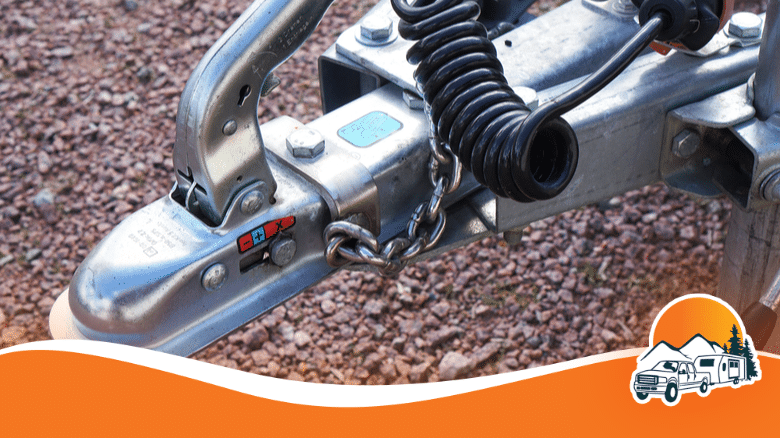
- Why does the RV travel ball hitch come in 4 different sizes?
- How do you pick the perfect size for your RV travel trailer ?
- How can you be sure about using the ball hitches accurately?
We answer these questions, and many others, in our detailed guide on the most common travel trailer ball hitch sizes. Stay with us for more.
The Most Common Sizes for Ball Hitch
Ball hitches come in numerous shapes and sizes, but most travel trailer owners prefer 4 sizes.
The most popular trailer hitch ball size includes:
- 1-7/8-inch hitch size ball : The 1-7/8-inch hitch ball is used for towing lightweight travel trailers weighing under 3,600 lbs. Other smaller RV travel trailers can work perfectly with this size, but most trailers weigh above 3,600 lb. and will not work with this size.
- 2-inch hitch size ball : The 2-inch hitch ball is for towing medium-weight travel trailers. This hitch ball can tow travel trailers weighing around 12,500 lbs.
- 2-5/16-inch hitch size ball: These balls are meant for towing heavyweight travel trailers weighing 22,000 lbs. or more. These balls are durable and manage more weight than others. Their sturdy nature and additional durability make them the most common travel trailer ball size for all weight categories.
- 3-inch hitch size ball: The 3-inch balls are used for towing goosenecks. RV owners do not use the towing hitch ball for fifth wheels or travel trailers.
The 2-5/16-inch hitch ball is the preferred size for most RV travel trailers and trucks. The 2-inch hitch ball can also work well for some travel trailers but might be underpowered for heavier trailers. Just to clarify, the ball sizes are based on the radius of the circular ball. There are other metrics as well, including the circular shaft of the ball to use as a sizing guide.
Tips to Follow While Using Your Travel Trailer Hitch
Using an adjustable travel trailer hitch may seem confusing, but it can be made easier with the right tips and tricks. We have mentioned some suggestions below to maintain your hitch in good health and reduce complications.
Watch the Hitch Ball Weight Ratings
It is essential that you do not exceed the recommended weight for your towing trailer ball hitch. Your travel trailer ball hitch can only tolerate a limited amount of weight, so you shouldn’t go beyond the weight capacity of your ball hitch. Exceeding the weight limit by even a few pounds can significantly depreciate your ball hitch.
The total limit of your travel trailer ball hitch is the circular ball capacity. Your hitch ball isn’t the only component you must remember. The hitch itself and the ball mount located in the RV trailer also have weight limits. You should study the cumulative weight limits of all three parts and not exceed the lowest value.
You can find the total limit for your hitch on a white piece of paper inside the product. The weight limit of the ball mount will also be mentioned along the shaft. As mentioned above, your total weight limit should not exceed the lowest limit. For instance, if your hitch has a weight limit of 9,000 lbs, your ball comes with a rating of 10,000 lbs, and your mount has a weight limit of 8,000 lbs, then the towing limit for your towing mechanism is 8,000 lbs.
Match the Coupler and Hitch Ball Size
The typical ball hitch size in your RV trailer won’t work if it isn’t the same size as the coupler. The coupler connects your RV trailer with the hitch and directly interacts with the ball. The coupler works to create a shaft across the surface of the ball and clamps it under a pin lock.
Many RV owners aren’t concerned about the size of their hitch ball and the coupler. Even a slight deviation of 0.1 inches can disrupt the fit between the coupler and your hitch ball. The coupler and your camper trailer hitch ball should be the same size.
Lubricate Frequently
You should frequently lubricate the ball hitch to avoid any errors in operations. You should not use the hitch without lubrication. Lubrication can improve the structural integrity of the towing mechanism and also limit the noise and errors that come from a rusty mechanism.
Remember also to apply grease on your hitch twice every year. The grease will keep the mechanism fully lubricated and will reduce friction between the moving parts. Make sure you wipe away the previous layer of grease before you apply a new coat.
Maintain a Level
Your tow vehicle and travel trailer should be at the same level from the ground. However, this level is hard to achieve in the real world. In most cases, you will find it difficult to adjust the levels. Once you have measured a rise or a drop between the tow vehicle and the trailer, you can find a ball with a similar rating.
Use a Pin Lock on Your Hitch
Who’s going to steal my travel trailer? This is what every traveler thinks before going out on a travel excursion. However, travel trailer thefts are on the rise, and chances are you could be next on the list if you don’t have a pin lock to protect your hitch.
A travel trailer can be a hefty investment and should be protected and looked after by all possible means. The last thing you want is to be without all your belongings and a place to sleep during your vacations. Knowing the problems that may come from a stolen travel trailer, you should use a hitch pin lock on your towing mechanism.
A hitch pin lock comes in two styles: coupler-style and receiver-style. Both types of locks can be sturdy in nature, with the coupler lock even providing protection when the travel trailer is not hooked.
Utilize a Weight Distribution Mechanism
A weight management mechanism is suggested by most people when towing a travel trailer. A good weight distribution hitch can distribute the weight of your travel trailer equally across the towing vehicle and can reduce sways on the road. Additionally, the weight distribution can help decrease the load on your back axle and limit wear and tear.
A weight distribution mechanism is usually made up of spring bars that go from the tow vehicle to the back end of the trailer. The springs can distribute the load equally across the front and rear axles. The added stability can improve the smoothness of the ride and lead to minimal road swaying. Turning might become difficult with a weight distribution mechanism, but the benefits far outweigh the cons.
Benefits of Using Adjustable Travel Trailer Hitches
Adjustable travel trailer hitches are much more convenient than fixed travel trailer hitches. An adjustable travel trailer hitch allows you to haul multiple travel trailers behind your vehicle without worrying about adjustability or ease of use. Perhaps the only downside associated with using an adjustable travel trailer hitch is that it comes with numerous moving parts in one place.
Multiple parts increase the chances of component failure and the overall depreciation of the device before you want. However, this shouldn’t be a major turn-off for you since an adjustable trailer hitch also has many advantages. They include:
Adjustable Height
Perhaps the most important advantage of going in favor of adjustable trailer hitches is that they can be controlled to your liking. You have the unique advantage of controlling the height and location of your adjustable trailer hitch and the ball located on it.
You can use the ball and pin method to adjust the hitch’s height. Adjusting the height of your hitch will save you from applying extra grease or lubrication on the ball. The ball will also perform well for a longer period, saving you from additional upkeep towards maintenance and longevity.
Easy to Operate
Adjustable trailer ball hitches are extremely easy to operate. If you have properly lubricated your hitch and have taken care of routine upkeep, you will find it easy to adjust the hitch to your liking. A fixed hitch, on the contrary, will have to be taken care of each time it is removed from the trailer. An adjustable hitch makes it easy for you to tow different trucks and achieve an appropriate level.
The travel trailer ball hitch is by far one of the most important components of your entire RV towing system. The little ball acts as a conduit between your hitch and the travel trailer, which is why it is highly necessary that you buy the right one.
As we have mentioned above, you should look to buy the 2-5/16-inch size because it can cover travel trailers weighing around 12,000 lbs. The 2-inch hitch ball size can be a bit underwhelming and may not be able to tolerate the weight of all travel trailers.
Additionally, regardless of the size you are towing, you should know that the entire setup is well-calibrated and in sync. Every travel trailer has unique requirements based on the design and hitch placement. Study the ball’s placement, and go through this article in detail to get the most out of your travel trailer hitch ball.
Popular on Ever RV Right Now!
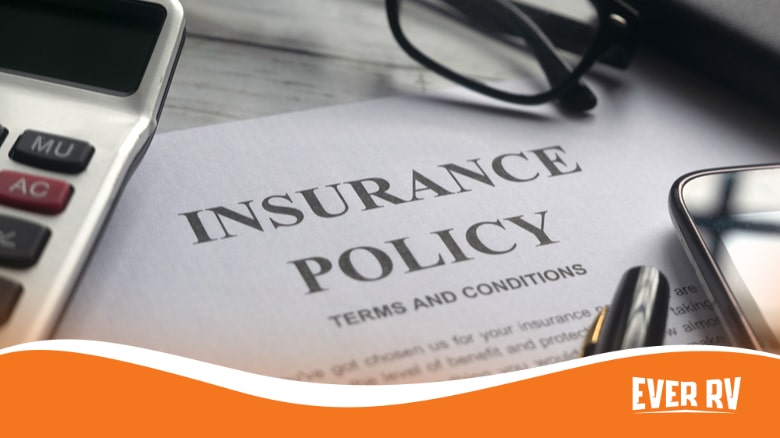
Campervan Insurance Essentials: Securing Your Home on Wheels
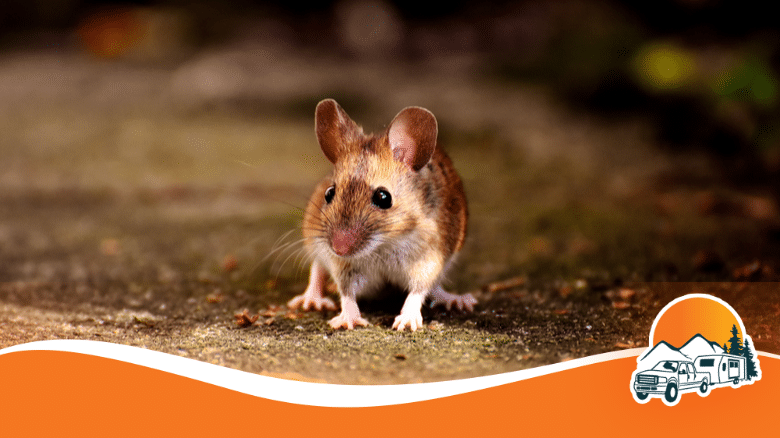
How Do I Keep Mice Out of My Camper?
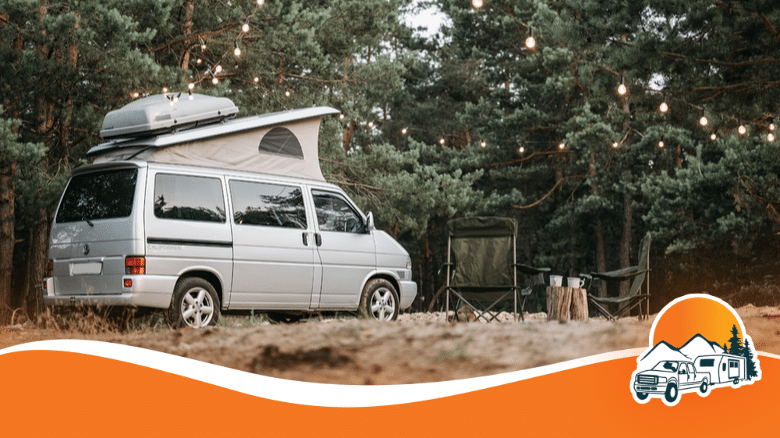
Class B Motorhome Insurance: Your Ultimate Protection Guide

How to Prevent Your Hair from Smelling Like a Bonfire
Disclosure: Our content is reader-supported . This means if you click on some of our links, then we may earn a commission. See how WPBeginner is funded, why it matters, and how you can support us.
About Editorial Staff
We’re passionate about all things RV and camper, and love sharing tips, “how-to”, and reviewing the latest products to help make your camping experience a success!

The Ultimate
Rv newsletter.
Stay informed about the latest news, tips, and trends in the world of RVing. PLUS receive exclusive offers and discounts on RV-related products and services.
Useful RV Guides
Class c motorhome insurance: comprehensive coverage explained, do i need a weight distribution hitch essential towing facts explained, how long to grill onions in foil, how much does it cost to store an rv (spoiler alert: not a fortune), how to clean the underside of a camper awning (spoiler alert: it’s super simple), how to get rid of rv sewer smell, travel trailer vs. 5th wheel – 13 things to consider before making a purchase.

10130 Mallard Creek Rd, Suite 300 Charlotte, NC 28262 (704) 741-0509
Helpful Links
- Go To Home Page
- RV Guides and Camping
- RV Rental Guide
- About Ever RV
Support Links
- Terms of Service
- Privacy Policy
- FTC Disclosure
Copyright © 2023 Ever RV, All Rights Reserved. | Sitemap
Ever RV c/o EverRV.com is a participant in the Amazon Services LLC Associates Program, an affiliate advertising program designed to provide a means for us to earn fees by linking to Amazon.com and affiliated sites.
3230 Tullahoma Hwy, Winchester, TN 37398
Call Now: 931-361-1122
- Tractors & Implements
- A.R.E.Toppers
- Service and Repair
- Chattanooga
- Murfreesboro
- Consumer Finance
- Business Finance

The Most Common Travel Trailer Ball Hitch Sizes
Learn about the most common trailer ball sizes for safe and efficient towing. Discover how to choose the right size for your trailer hitch. Get expert tips!
When it comes to towing, choosing the correct trailer ball size is critical for safe and successful transportation. Important considerations when choosing a trailer ball size include the weight capacity of the towing vehicle, the trailer coupler size, the shank diameter and length, the weight rating of the ball mount, and the tongue weight of the trailer. This in-depth guide provides everything you need to know when it comes to the most common trailer ball sizes, plus how to choose the size that’s right for your trailer!
What is a Hitch Ball?
A hitch ball, also known as a trailer ball, is a component of a trailer hitch system. It is the part that attaches the towing vehicle to the trailer being towed. The hitch ball sits on a ball mount, which then goes into the hitch receiver on the towing vehicle’s back end.
The hitch ball’s role is to provide a secure connection between the towing vehicle and trailer, enabling them to move together as a unit. The hitch ball also allows the trailer to move independently from the towing vehicle, making turns and maneuvers possible.
What is a Ball Mount?
A ball mount is an essential component in a trailer hitch system that connects the trailer to the towing vehicle. It consists of a shank that slides into the hitch receiver and a ball platform where the hitch ball is attached. The ball mount provides a secure and stable connection between the trailer and the towing vehicle, allowing for safe towing.
There are different types of ball mounts available to suit different towing needs. Fixed ball mounts are a popular choice for those who tow the same trailer regularly, as they provide a permanent and secure connection. On the other hand, adjustable ball mounts offer more flexibility as they can be adjusted to fit various trailers with different coupler heights. This type is perfect for those who tow different trailers, or if the towing vehicle is shared among multiple drivers.
Here’s how to determine what type of trailer you need >>
When choosing a ball mount, it is important to consider the weight capacity and the rise/drop measurements. The weight capacity refers to the amount of weight the ball mount can safely tow, while the rise/drop measurements take into account the height difference between the hitch receiver and the trailer coupler. It is essential to choose a ball mount that has the correct weight capacity and rise/drop measurements for safe and effective towing.
Standard Trailer Hitch Ball Sizes
Standard trailer hitch ball sizes refer to the common ball diameter sizes used in trailer hitches, which are usually either 1-7/8″, 2″, or 2-5/16″.
The 1-7/8″ ball size is commonly used for light-duty towing, such as small utility trailers or pop-up campers that have a weight capacity of up to 2,000 pounds.
The 2″ ball size is the most popular and commonly used size for medium-duty towing, such as travel trailers, boat trailers, and small to medium-sized cargo trailers, with a weight capacity of up to 8,000 pounds.
The 2-5/16″ ball size is usually reserved for heavy-duty towing, such as large travel trailers, horse trailers, and equipment trailers that have a weight capacity of up to 30,000 pounds.
In addition to the ball size, other factors such as the shank length, shank diameter, and weight rating of the ball mount should also be taken into consideration to ensure safe towing. Using a weight distribution hitch and ensuring the hitch receiver and receiver tubes are compatible can also help distribute the weight of the trailer more evenly and improve stability during towing.
What’s the Most Common Trailer Ball Size?
The size of the hitch ball is determined by the diameter of the ball itself, which is measured in inches. While there are various ball sizes available, the most common trailer ball size is 2 inches in diameter.
The popularity of the 2-inch trailer ball size can be attributed to its versatility and compatibility with different trailers. This size is ideal for light-duty towing of small to medium-sized trailers that are commonly used for hauling cargo, motorcycles, and personal watercraft. Additionally, most travel trailers and pop-up campers also require a 2-inch ball, making it an ideal choice for recreational towing purposes.
Other popular ball sizes include 2-5/16 inches, which is commonly used for towing heavier trailers such as horse trailers, flatbed trailers, and RVs. However, the 2-5/16 inch is not as versatile as the 2-inch size and is not compatible with all trailers.
How to Tell What Size Trailer Ball Do I Need?
When towing a trailer, choosing the correct trailer ball size is critical for safe and efficient hauling. Here are the step-by-step instructions on how to determine the correct trailer ball size needed:
Step 1: Check Your Owner’s Manual
The first step in determining the correct trailer ball size is to check the owner’s manual of your towing vehicle. It will provide essential information regarding the towing capacity, tongue weight limit, and compatible hitch size.
Step 2: Check Your Coupler Size
The second step is to measure and determine the size of the coupler on your trailer. The coupler is the part of the trailer that sits on the towing ball and locks in place. Measure the diameter of the coupler to ensure the correct trailer ball size. Standard coupler sizes are 1-7/8 inch, 2-inch, 2-5/16 inch, or 3 inches.
Step 3: Determine Your Trailer Weight
The third step is to determine the weight of your trailer. It is essential to know the weight of the trailer to choose the correct trailer ball size to ensure safe hauling. You can use a specialized scale or weigh the trailer on a commercial scale.
Step 4: Consider Your Shank Length and Diameter
The fourth step is to consider the shank length and diameter of the trailer ball. The shank is the part of the trailer ball that goes into the trailer hitch. The length and diameter of the shank should match the hitch receiver and receiver tube of the towing vehicle.
Step 5: Consider Weight Distribution
If the trailer weight is more than 50% of the towing vehicle’s weight, using a weight distribution hitch is necessary. A weight distribution hitch helps distribute the weight evenly between the trailer and the towing vehicle.
Step 6: Consult with Your Trailer Dealer or Mechanic
If you are still unsure which trailer ball size you need, consult with Penner Trailer Sales or your local trailer dealer or mechanic. They can provide advice and information on choosing the correct trailer ball size for your specific towing needs.
How Do You Measure Ball Hitch Size?
Measuring the diameter of a hitch ball accurately is an important step in selecting the correct trailer hitch and coupler. Here are step-by-step instructions on how to measure the diameter of a hitch ball:
- Step 1: Find a tape measure or caliper that can accurately measure small distances.
- Step 2: Place the hitch ball on a flat, level surface.
- Step 3: Measure the diameter of the ball with a tape measure or caliper. If you choose to use a tape measure, wrap it around the widest part of the ball to measure the diameter. If you prefer to use a caliper, insert the tool through the hole of the hitch ball and open it until it reaches the outside edge of the ball.
- Step 4: Ensure you are measuring the diameter and not the shank length or threaded stem as this can result in incorrect sizing.
- Step 5: Take note of the measurement in either inches or millimeters. The most common sizes for hitch balls are 1-7/8 inches, 2 inches, and 2-5/16 inches.
When measuring the diameter of a hitch ball, there are a few special considerations to keep in mind. It is important to measure the ball across the threads if it has them, to ensure accuracy. Additionally, using a caliper can provide more precise measurements, whereas a tape measure may be less accurate.
Why Do the Ball Hitch and the Coupler Have to Be the Same Size?
The ball hitch and coupler must be the same size in order for the trailer to be stable and properly connected to the tow vehicle. Mismatched ball hitches and coupler sizes can result in trailer instability, detachment, and numerous other risks. It can also lead to overweight or underweight loads, which can be extremely hazardous and cause accidents or damage to the trailer or tow vehicle.
Should I Carry Different Ball Hitch Sizes with Me?
Carrying multiple ball hitch sizes can prove beneficial in certain situations. The most common ball hitch sizes are 2-inch and 2-5/16-inch balls, which fit most travel trailers and heavy trailers. However, if you are towing different trailers, having different ball hitch sizes can ensure a snug fit and better weight distribution.
For instance, if you have a small utility trailer and a larger travel trailer, you might require two different ball hitch sizes. Using a 2-inch ball on a trailer with a gross weight capacity of 10,000 pounds is not safe and could cause problems while towing. Similarly, using a 2-5/16-inch ball on a small utility trailer could result in it being too loose and unstable during transport.
Carrying different ball hitch sizes can also be beneficial when you need to help someone in need. Imagine a scenario where a fellow traveler is stranded on the roadside with a trailer, and they have a different ball size. Having the right ball hitch size with you can make the difference between a safe journey and a nightmare.
Pro Tip: If you decide to carry different ball hitch sizes, ensure that you have the necessary ball mount with the correct shank diameter, shank length, and weight rating for each ball. You can also invest in a weight distribution hitch, which can help redistribute the weight of the trailer on the towing vehicle and improve stability.
Tips for Using Your Travel Trailer Ball Hitch
Here are some tips to help you use your travel trailer ball hitch with confidence.
1. Choose the Correct Hitch Ball Size: The most common hitch ball sizes are 1-7/8 inches, 2 inches, and 2-5/16 inches. Check your trailer coupler size before purchasing a hitch ball, so you can ensure a proper fit.
2. Use a Weight Distribution Hitch: If you’re towing a heavy trailer, a weight distribution hitch can help distribute the weight more evenly across the tow vehicle and trailer axles. This can improve handling, stability, and braking performance.
3. Check the Tongue Weight: Before towing, make sure the tongue weight (the amount of weight that rests on the hitch ball) is within the recommended range. Too little tongue weight can cause sway, while too much can overload the tow vehicle’s suspension.
4. Lubricate the Hitch Ball: Using a lubricant on the hitch ball can help reduce friction and wear, making it easier to hitch and unhitch the trailer.
5. Hitch and Unhitch Carefully: When hitching the trailer, make sure the coupler is securely attached to the hitch ball and locked in place. When unhitching, use a jack to lift the trailer slightly and take the weight off the hitch ball before releasing the coupler.
6. Inspect Regularly: Regularly inspect your trailer ball hitch for any signs of wear or damage. Check the hitch ball, coupler, and safety chains for any cracks, corrosion, or other issues.
7. Observe Speed Limits: When towing, adhere to posted speed limits, and reduce your speed in inclement weather or rough road conditions.
8. Be Prepared for Emergencies: In case of an emergency, make sure you have a spare tire and the necessary tools to change it. Carry an emergency kit with items like a flashlight, first-aid supplies, and extra water and food.
By following these tips, you can use your travel trailer ball hitch safely and with confidence. Remember to always prioritize safety when towing.
Travel Trailer Ball Hitch Sizes Don’t Have to be Confusing
Penner Trailer Sales is a reliable source for all your trailer ball size needs. Trailer balls are a vital part of towing, and having the correct size ensures safe and efficient transport. Our team of experts can assist you in selecting the right size based on weight capacities, coupler size, tongue weight, and trailer weight limit.
We offer a wide range of standard sizes, including 2-inch and 2-5/16-inch balls, which are the most common hitch ball sizes for light-duty towing and travel trailers. For heavier trailers, we recommend the use of a 3-inch ball hitch. Our trailers also come equipped with a trailer ball hitch size and coupler height that is appropriate for the towing vehicle.
Contact us today to get all your travel trailer questions answered!
Visit Our Dealership
3230 tullahoma hwy. winchester, tn, 37398, dealership hours.
Mon-Fri: 8:00 a.m. – 5:00 p.m. Sat: 8:00 a.m. – 12:00 p.m. Sun: CLOSED
Connect with Penner Trailer Sales
© 2024 Penner Trailer Sales
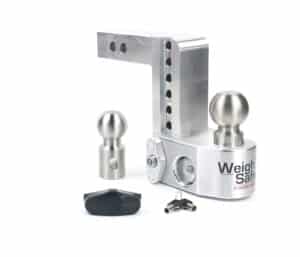
WEIGH SAFE ADJUSTABLE BALL MOUNT
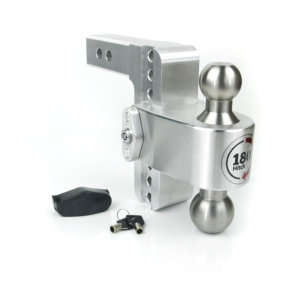
TRUE TOW WEIGHT DISTRIBUTION
Heavyweight, middleweight.
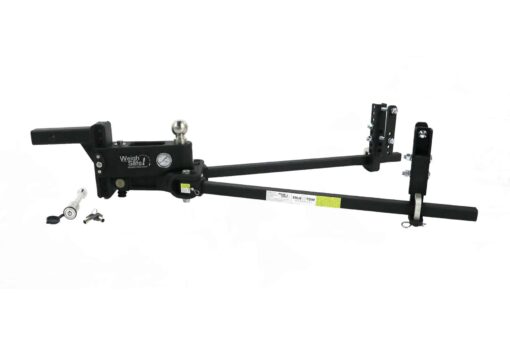
HEAVYWEIGHT - ORIGINAL
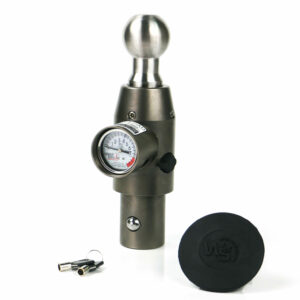
WEIGH SAFE HITCH PIN LOCK
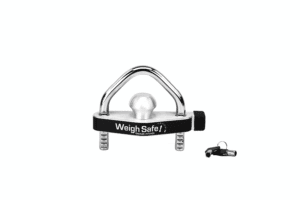
WEIGH SAFE CLAMSHELL CONVERTER
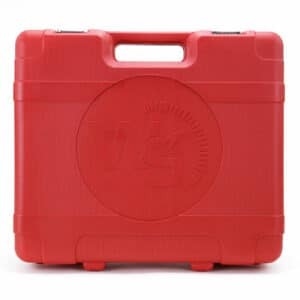
WEIGH SAFE STORAGE CASE
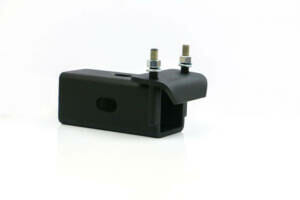
WEIGH SAFE ANTI-RATTLE REDUCER
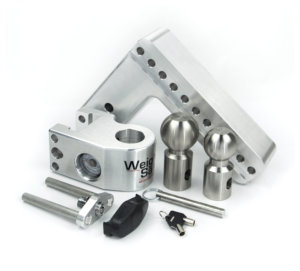
WEIGH SAFE ACCESSORIES & PARTS
- About Weigh Safe
- Brand Ambassador
- Social Media
- Frequently Asked Questions
- Return Policy
- Weigh Safe App
- Dealer Locator
- Authorized MAP Policy
- Become A Dealer
- Dealer Content
- Dealer Portal
- New Dealer Registration
- Unauthorized Dealers
- Search for:
No products in the cart.
Return to shop
Towing Safety
Choosing your trailer ball hitch size: a step-by-step guide.
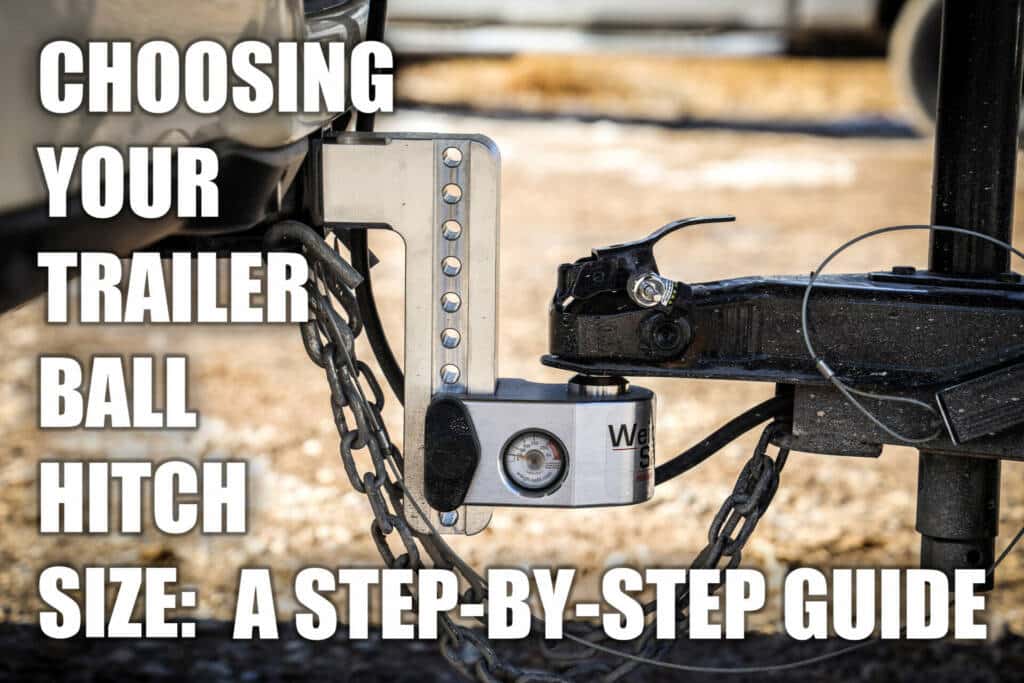
What is a Hitch Ball?
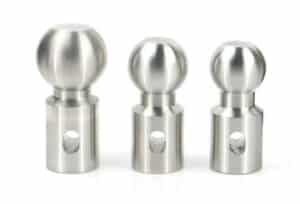
What is a Ball Mount?
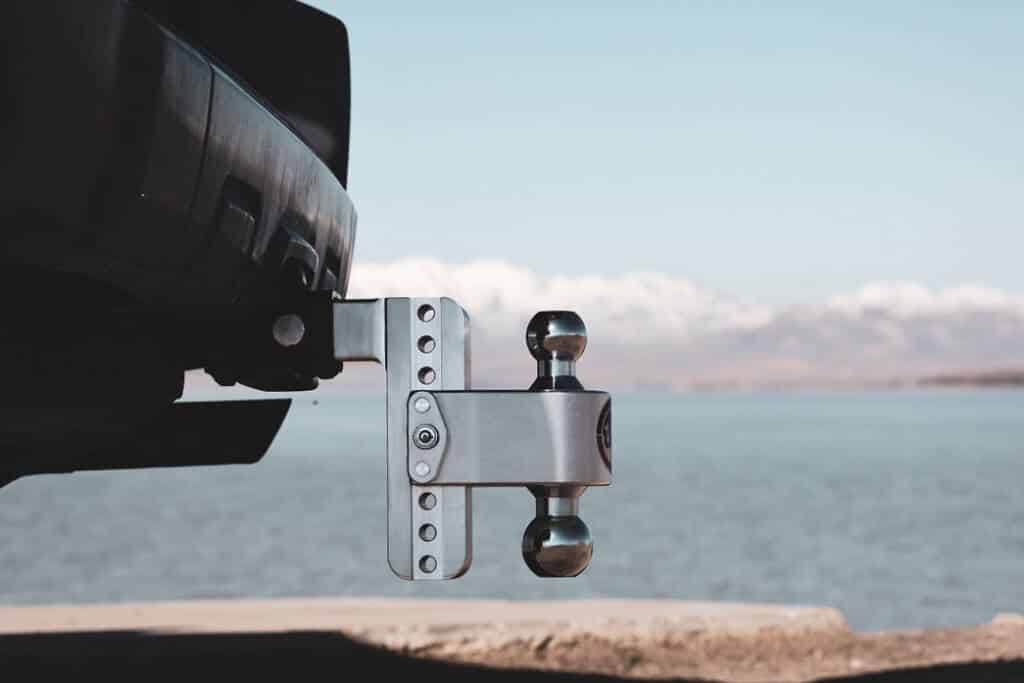
3 Standard Trailer Ball Hitch Sizes
5 most important things to consider when selecting a ball mount, #1 – how much weight will you be towing.
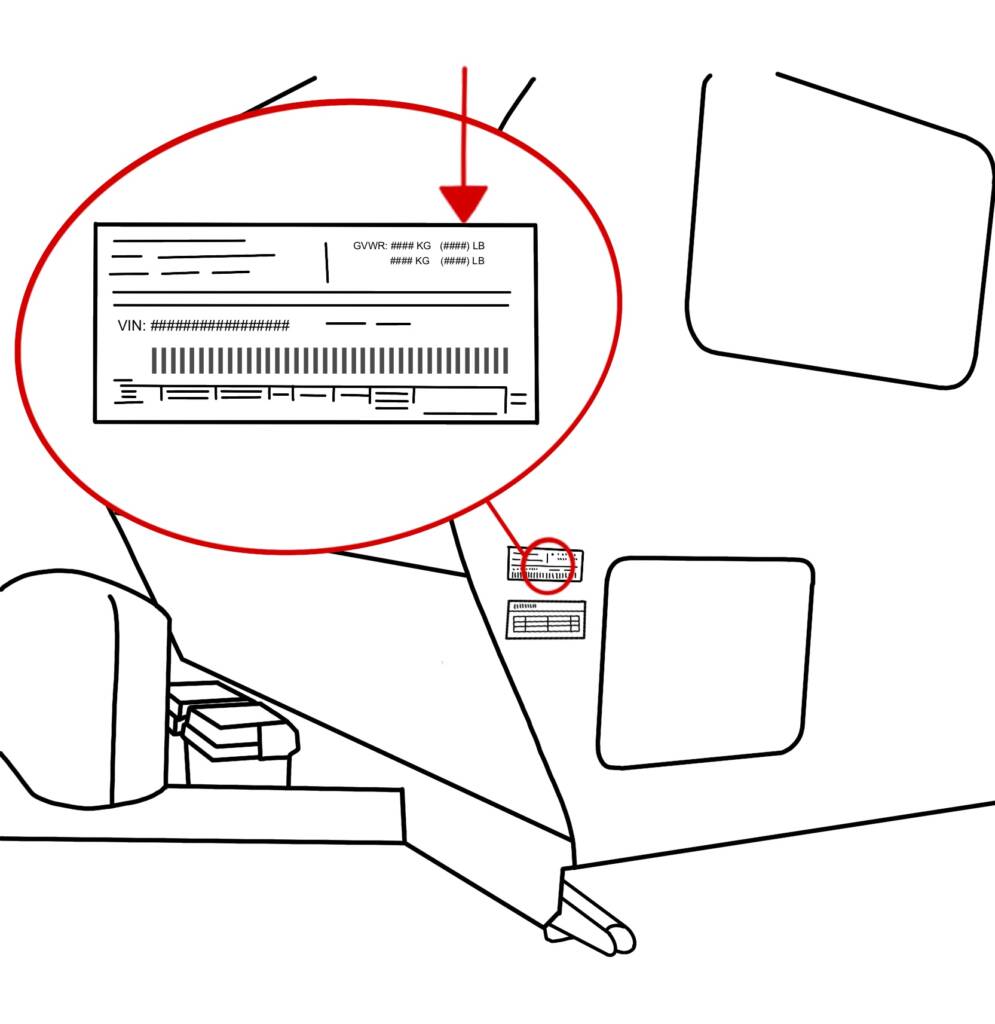
- GVWR – Gross Vehicle Weight Rating (the total maximum amount your trailer can safely weigh when loaded).
- GAWR – Gross Axle Weight Rating (the maximum amount of weight that can be placed over each axle)
- Payload Capacity – the maximum amount of cargo weight that you can safely load onto your trailer (your trailer’s load limit)
- Trailer Weight – this is how much your trailer weighs empty
✅ The weight rating of your tow ball must match or exceed your trailer’s GVWR.
weigh safe adjustable drop hitch.
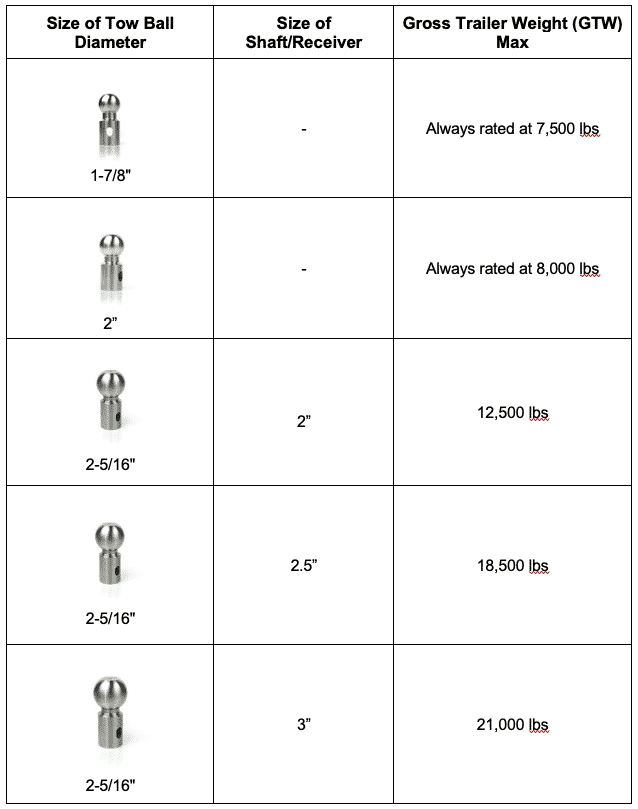
Weigh Safe Fixed Height Ball Mount
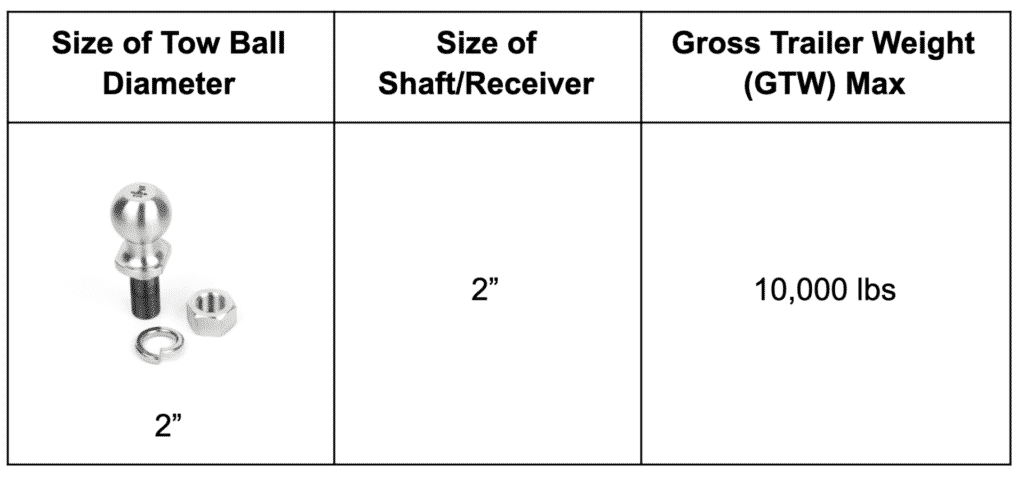
Weigh Safe Universal Tow Ball

Weigh Safe Clamshell
#2 – what tow ball diameter does your trailer’s coupler head require, ✅ the diameter of your tow ball must match the size of your trailer’s coupler opening size. .
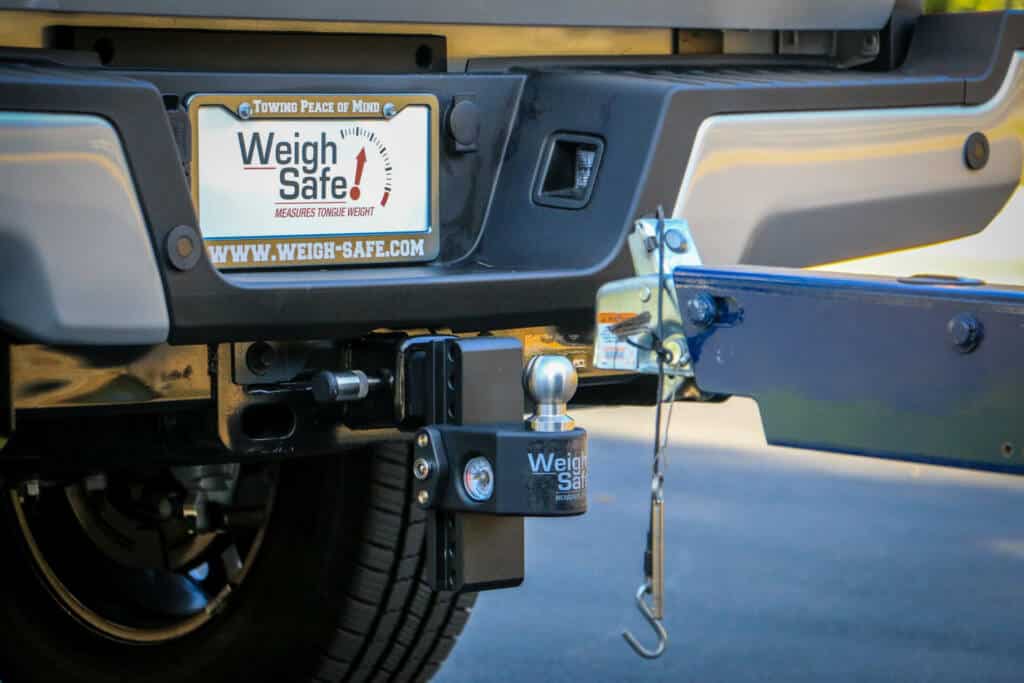
#3 – What size and class of receiver does your truck have?
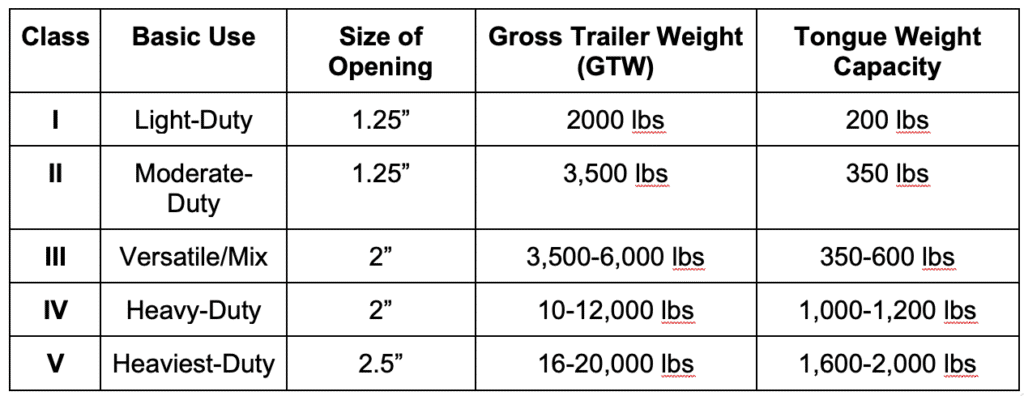
✅ The shaft of your ball mount must match the size of your truck’s receiver tube opening.
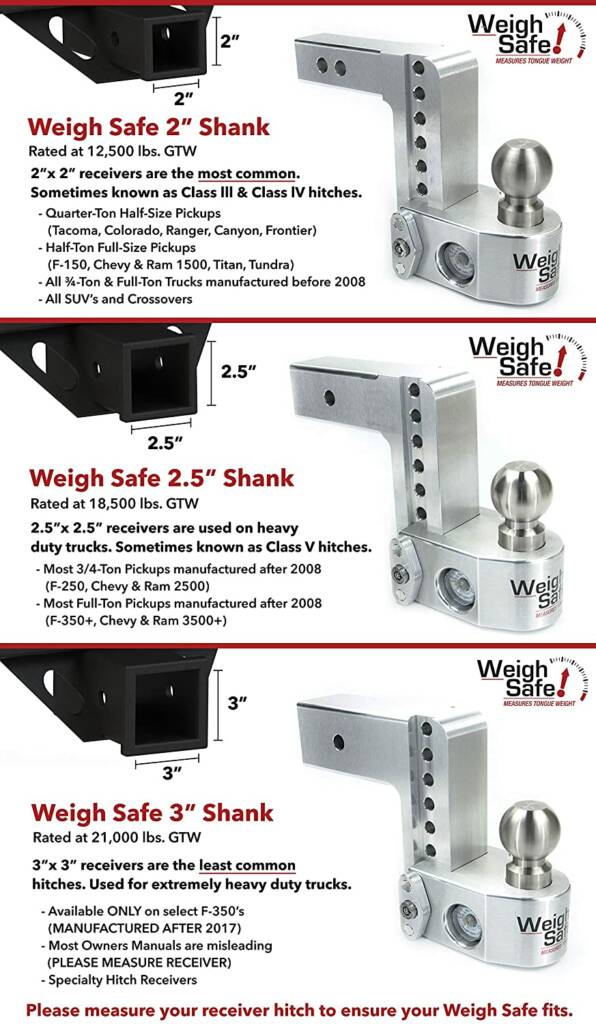
#4 – How much rise or drop do you need to provide a level and safe towing setup?
Drop length formula (for trailers that ride lower than your truck).
- Measure the distance from the bottom of your trailer’s coupler to the ground (be sure your trailer is loaded and sitting level with the ground while you measure).
- Subtract this number from the height of your hitch receiver (distance from the top of the inside of your truck’s hitch receiver to the ground).
- This is the required drop length of your ball mount.


Rise Length Formula (for trailers that ride higher than your truck)
- Measure distance from the bottom of your trailer’s coupler to the ground (be sure your trailer is loaded and sitting level with the ground while you measure).
- From this number, subtract the height of your hitch receiver (distance from the top of the inside of your truck’s hitch receiver to the ground).
- This is your required rise length of your ball mount.
✅ Your ball mount must meet the height of your loaded trailer
Need help deciding which size draw bar you need , hitch clearance formula .
- Find your required drop length (use drop length formula above).
- Add 3 inches.
- This is your total hitch length. Subtract this number from the height of your truck’s hitch receiver (distance from the top of the inside of the hitch receiver to the ground).
- This is your hitch’s amount of clearance and should be no less than 13 inches when the hitch is unloaded (uncoupled from the trailer).
- Your hitch’s clearance should be no less than 11 inches when the hitch is loaded (coupled to the trailer and bearing tongue weight).
How to Choose the Right Size Hitch Video
# 5 – How will you measure your trailer’s tongue weight?
How tongue weight affects your truck’s stability and handling.
A Weigh Safe Trailer Hitch is the only hitch with a built-in scale to accurately measure your trailer’s tongue weight
How it works.
✅ Always measure the tongue weight of your trailer before you tow
Is there a one-size-fits all universal trailer ball.
- measuring tongue weight
- making vertical height adjustments
- switching between different tow ball sizes
- towing a variety of trailer types
The Most Common Ball Hitch Size
The most common ball hitch size for travel trailers.
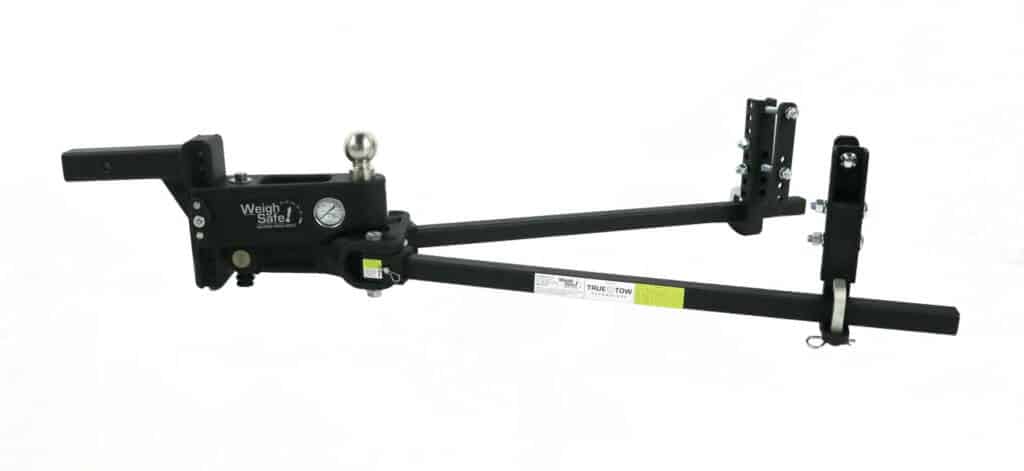
Do You Need a Weight Distribution Hitch?
Indicators you need a weight distribution hitch:.
- Your trailer weight (GTW) is more than 50% of your truck’s weight (GVWR)
- The rear of your truck sags when the trailer is hooked up
- You experience trailer sway
- Your truck’s headlights point upward
- You find it difficult to steer or stop
- You want to tow at your truck and trailer’s highest capacity
Do You Need a Gooseneck Ball?
Weigh safe 180 ball mount.
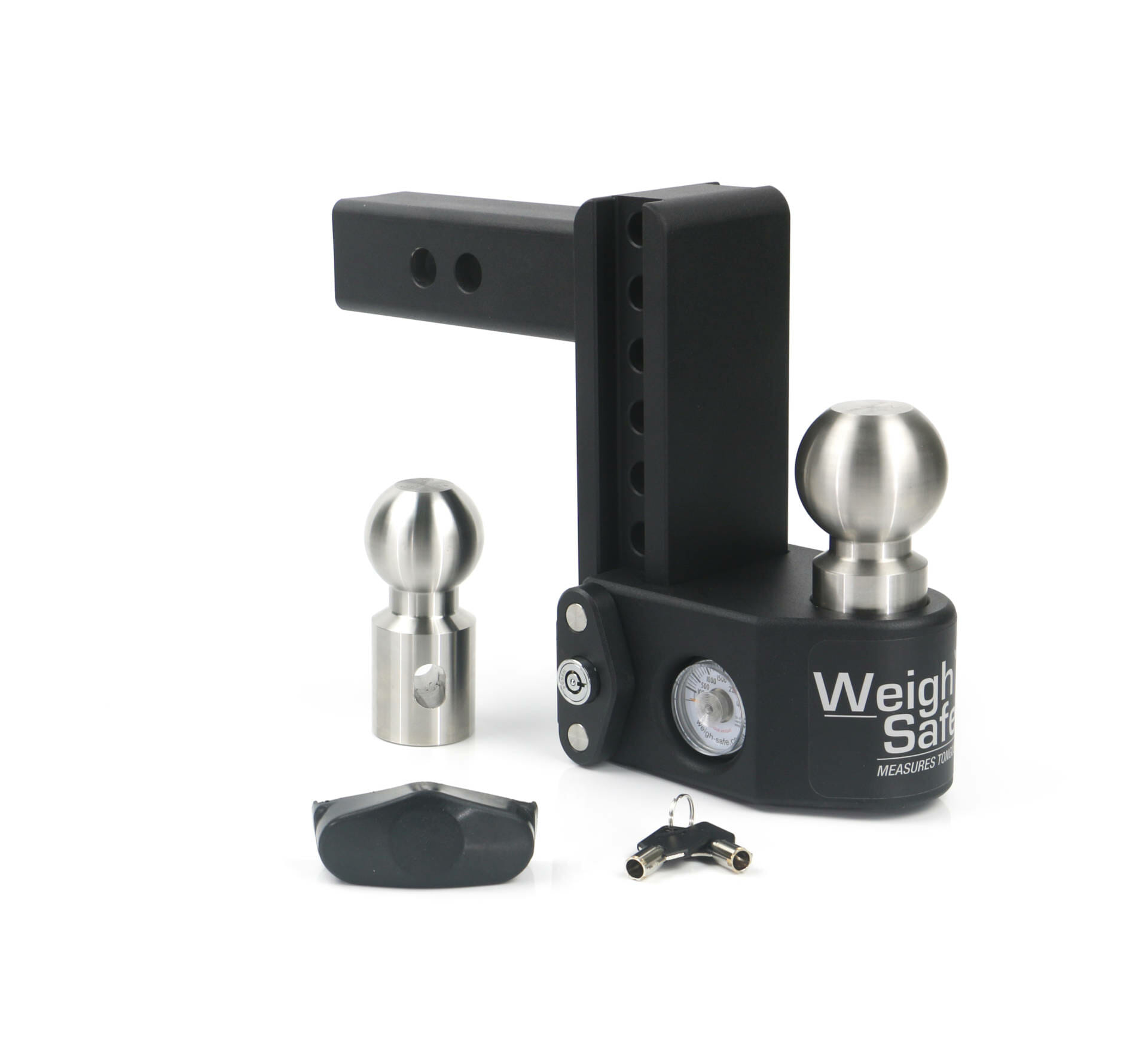
STEEL WEIGH SAFE ADJUSTABLE BALL MOUNT
Steel weigh safe 180 pro ball mount, weigh safe aero hitch, cerakote black weigh safe adjustable hitch, cerakote black weigh safe 180 ball mount, weigh safe fixed height ball mount.
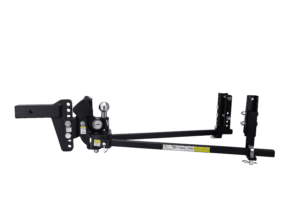
TRUE TOW HEAVYWEIGHT WEIGHT DISTRIBUTION - ORIGINAL
True tow middleweight weight distribution, weigh safe oem gooseneck, weigh safe b&w gooseneck, weigh safe in-bed rail gooseneck, weigh safe vehicle recovery hook, weigh safe soft shackle ring, weigh safe hard shackle, weigh safe cerakote recovery hook, weigh safe cerakote soft shackle, weigh safe ball coupler lock, weigh safe trailer coupler latch lock, weigh safe padlock, weigh safe 3pc lock set, weigh safe extra keys, weigh safe all locks & keys.
- WARRANTY/RETURNS
- ABOUT WEIGH SAFE
- NEW DEALER REGISTRATION
- DEALER RESOURCES
- DEALER LOCATOR
- BRAND AMBASSADORS
- SOCIAL MEDIA
Privacy Overview
Username or email address *
Password *
Remember me Log in
Lost your password?
Email address *
A link to set a new password will be sent to your email address.
First name *
Last name *
Phone *
I have read and agree to the website terms and conditions *
Your personal data will be used to support your experience throughout this website, to manage access to your account, and for other purposes described in our privacy policy .

Join Now Login
Back to the Learning Center >
Choosing the Right Connection: The Most Common Travel Trailer Ball Hitch Sizes
Introduction
When it comes to towing travel trailers, one of the most crucial aspects is ensuring that your hitch matches the trailer’s requirements. The ball hitch size is a fundamental factor to consider, as it determines the stability and safety of your towing setup. In this guide, we will explore the most common travel trailer ball hitch sizes, why they matter, and how to select the right one for your RV adventures.
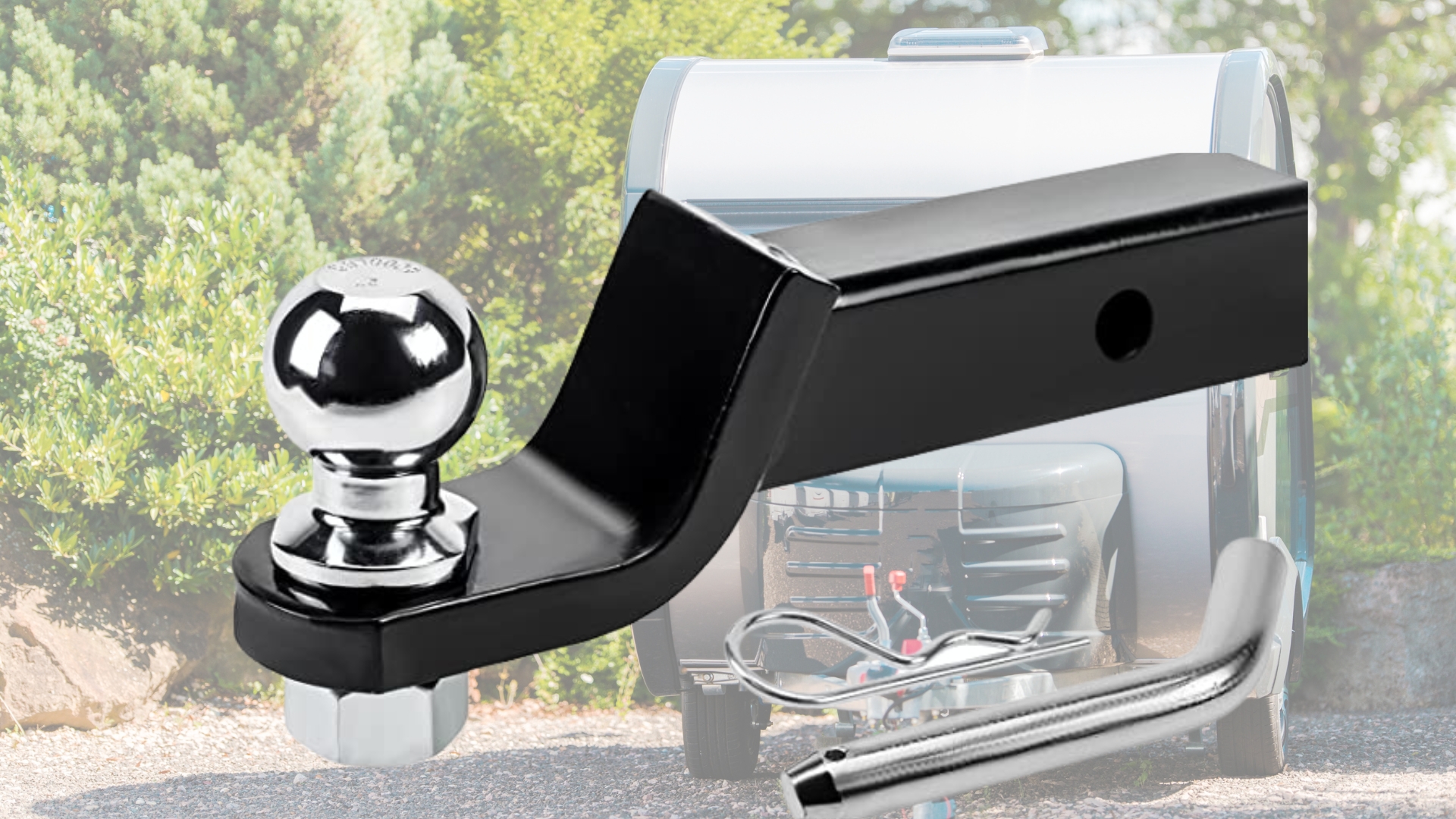
Why Does Ball Hitch Size Matter?
- Safety: A properly matched ball hitch size ensures secure and safe towing, reducing the risk of accidents and trailer sway.
- Stability: The correct size minimizes movement and vibrations between the tow vehicle and the trailer, enhancing stability on the road.
- Towing Capacity: The ball size should align with the trailer’s weight and towing capacity, optimizing performance.
- Compatibility: Selecting the right size allows you to connect your travel trailer to a wide range of tow vehicles, ensuring versatility.
Most Common Travel Trailer Ball Hitch Sizes
- 2-Inch Ball: This size is suitable for lightweight and smaller travel trailers, often with a gross trailer weight (GTW) of 3,500 pounds or less.
- 2-5/16-Inch Ball: The 2-5/16-inch ball is the most common size, typically used for medium to large travel trailers with GTWs ranging from 3,500 to 25,000 pounds.
- 1-7/8-Inch Ball: This size is less common but may be used for very lightweight trailers with GTWs under 2,000 pounds.
Selecting the Right Ball Hitch Size
- Refer to Your Trailer’s Manual: Check the owner’s manual or specifications for your travel trailer to find the recommended ball hitch size.
- Verify the Ball Size on the Coupler: The ball size is often stamped on the trailer’s coupler. Ensure it matches your hitch size.
- Consider Weight Ratings: Check the GTW and tongue weight of your travel trailer, and choose a ball hitch size that matches or exceeds these ratings.
- Consult the Tow Vehicle’s Manual: Your tow vehicle’s manual will provide information about the ball size and weight ratings it can accommodate.
- Use an Adjustable Hitch: If you plan to tow different trailers with various ball sizes, consider an adjustable hitch that allows you to switch ball sizes easily.
Selecting the right ball hitch size for your travel trailer is essential for safe and stable towing experiences. By understanding the most common sizes, referring to your trailer’s specifications, and considering weight ratings, you can confidently choose the appropriate ball hitch size. Taking the time to make this crucial connection ensures that your RV adventures are not only enjoyable but also secure and worry-free, whether you’re on a weekend getaway or an extended road trip.
Leave a Reply Cancel reply
You must be logged in to post a comment.
Forest River Ibex RVS1
Coachmen northern spirit 2963bh, coachmen northern spirit 2557rb, forest river ibex 19rbm.

Established in 2012 Campground Views is built by campers for campers
More links and information
Ⓒ 2019 - all rights are reserved.
Username or Email Address
Remember Me
Lost your password?
Create Free Account
>> Members login
Login to Your Account
Create an Account Here

Trailer Ball Sizes: What Size Trailer Hitch Do I Need?
When it comes to towing, your trailer ball is one of the most important pieces of equipment you will use. There are a variety of different trailer ball sizes and types available on the market.
It can be confusing trying to figure out which hitch ball size you need. In guide, we will explain the different types and sizes of trailer balls that fit your trailer.
Standard Trailer Ball Sizes
There are four standard trailer ball sizes: 1-7/8″, 2″, 2-5/16″, and 3″.
A trailer hitch ball’s “size” is the measurement of the ball’s diameter.
Tow balls come in standard sizes to make them easy to match up to trailer couplers.
As the ball size increases, so does the weight capacity it can handle.
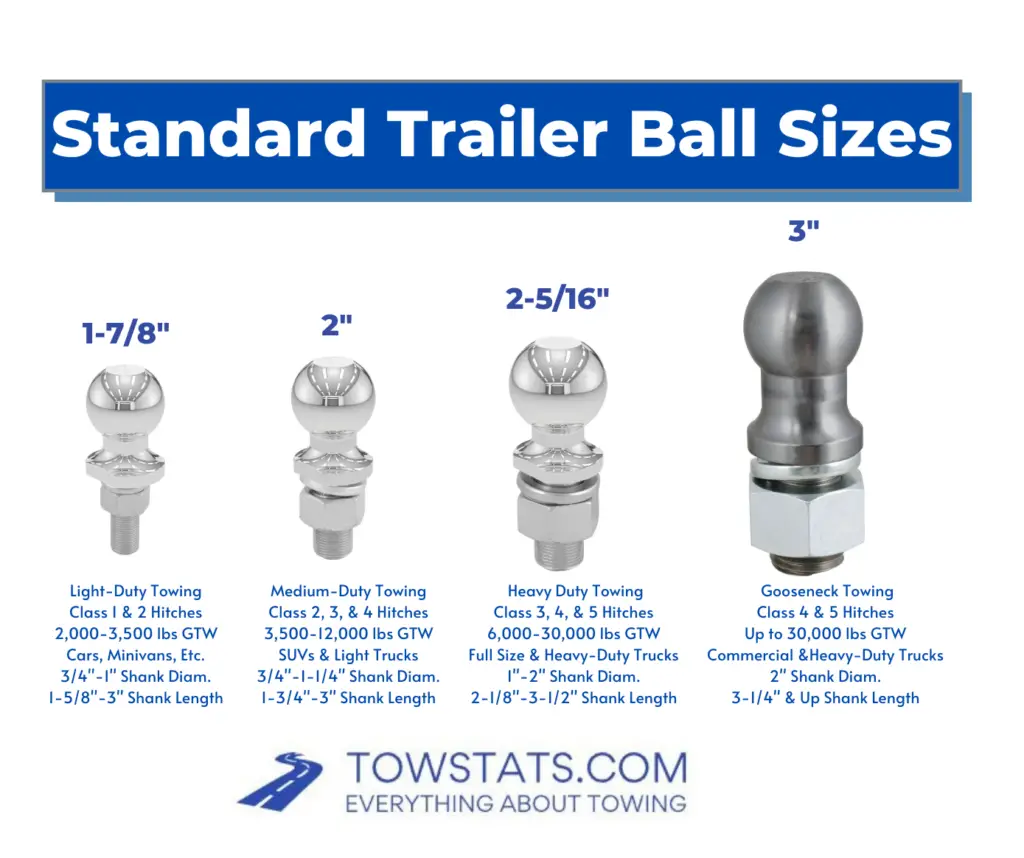
1-7/8″ Trailer Ball
1-7/8″ trailer balls are commonly used for light-duty towing like small utility trailers, fishing boat trailers, and teardrop campers.
2″ Trailer Ball
2″ trailer balls are the most common hitch ball size, and are best for pulling campers, utility trailers, and boat trailers.
2-5/16″ Trailer Ball
2-5/16″ trailer balls are used for towing travel trailers and larger utility trailers.
3″ Trailer Ball
3″ trailer balls are the largest and are usually used with gooseneck trailers, like livestock trailers or large travel trailers.
How To Measure Trailer Ball Size
There are four distinct measurements you’ll need when measuring trailer ball size:
- Ball Diameter: The diameter of the actual trailer ball
- Shank Diameter: The diameter of the threaded shaft
- Shank Length: The length of the threaded shaft
- Rise: The height of the trailer ball’s base
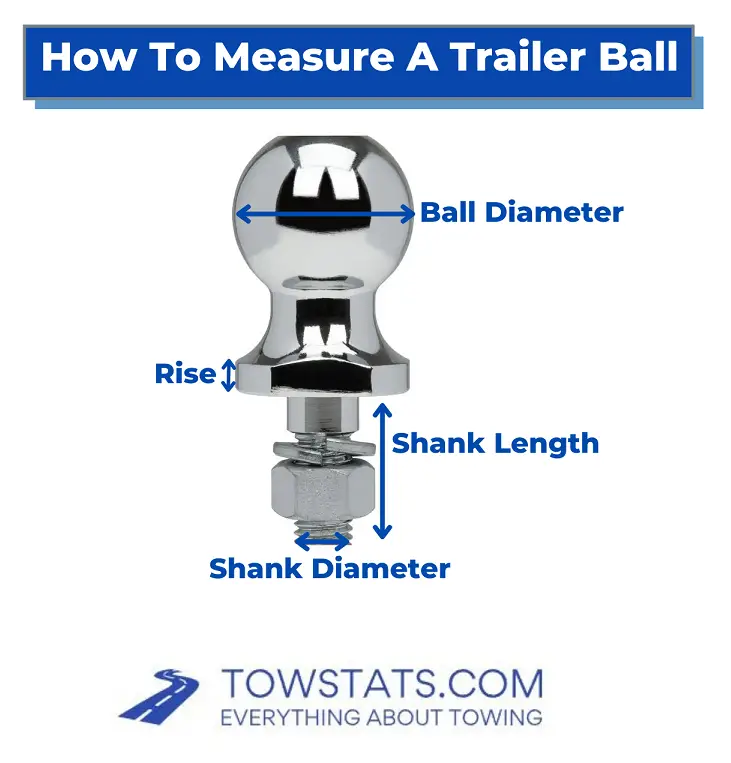
Measuring Trailer Ball Diameter
You can use a measuring tape to measure the diameter of your trailer ball to find out what size you have.
As a reminder, common sizes are 1-7/8″, 2″, 2-5/16″, and 3″.
Measuring Ball Shank Diameter
You can measure the ball shank diameter with a tape measure or piece of string the same way you measure the trailer ball diameter.
The three most common ball shank diameter sizes are: 3/4″, 1″, and 1-1/4″.
Measuring Ball Shank Length
Ball shank length isn’t the most important consideration unless you’re using other towing accessories that will need more shank length to be mounted, or if your situation calls for a special need.
Short ball shank length is less than 2″, medium length is 2″-3″, and long length is greater than 3″.
These usually go hand-in-hand with the trailer ball size.
Just make sure you have enough length beyond the thickness of your ball mount platform to adequately secure the nut and bolt on the ball shank.
Measuring Trailer Ball Rise
How to tell what size ball your trailer needs, trailer ball size chart.
Finding out what size ball you need for your trailer is a pretty simple process.
You’ll need to know three things:
- The size of your trailer coupler
- Your trailer ball hole diameter
- Your towing capacity
Measuring Coupler Size
Fortunately, this step is pretty easy.
Almost all trailer manufacturers stamp or etch the trailer ball size on the coupler.
If yours doesn’t have it stamped on there, you can always look it up according to the manual or on the manufacturer’s website.
If that doesn’t work, you can measure the inside opening of the coupler with a tape measure or ruler.
Measuring Trailer Ball Hole Size
This is an important step, because the hole your trailer ball mounts to must be sized properly.
The trailer ball has a shank, or threaded cylinder attached to it that you insert into the trailer ball hole and secure with a nut and bolt on the other side.
If the hole and ball shank sizes don’t match up, the ball will shift around and could come loose during towing.
Measure the diameter of the trailer ball hole with a measuring tape to find out what size shank it will accept.
Matching Your Towing Capacity
Each trailer ball has a “ball capacity”, which is the weight rating that the trailer ball can handle.
The ball capacity refers to the gross trailer weight limit, not the tongue weight, so keep this in mind when picking one out.
You can find the hitch ball rating on the top of the ball or around the base of the shank.
Keep in mind that the weight rating of your tow ball must match or exceed your trailer’s Gross Vehicle Weight Rating (GVWR).
Consider your vehicle’s towing capacity, your trailer’s gross trailer weight (GTW), and the tow receiver hitch size you have when choosing a trailer ball.
Frequently Asked Questions
The most common hitch ball size is a 2″ ball. The 2″ ball is commonly found on Class 3 hitches, which are the most common trailer hitch used on tow vehicles.
The most common boat ball size is 1-7/8″ or 2″. These will fit the couplers found on most boat trailers.
The most common jet ski trailer ball size is 1-7/8″ or 2″. These will fit the couplers on most jet ski trailers.
All U-Haul trailers can be towed using a 1-7/8″ or 2″ trailer ball.
The most common travel trailer hitch ball size used is a 2″ or 2-5/16″.
No, there are no universal or one-size-fits-all trailer ball options. This is for safety reasons, and you should never use a trailer ball size adapter or anything else to get the size of your trailer ball to match your coupler. There are options called switch ball sets that have a universal ball shank that you can tighten on different trailer ball sizes as needed.
The recommended torque values for attaching trailer balls to a ball mount are defined by the shank diameter as follows: 3/4″ Shank Diameter: 150ft-lb of torque 1″ Shank Diameter: 250ft-lb of torque 2-5/16″ Shank Diameter: 450 ft-lb of torque
Leave a Comment Cancel reply
Save my name, email, and website in this browser for the next time I comment.
Terms and Conditions - Privacy Policy
MeasuringHow
What Are The Standard Hitch Ball Sizes? Complete Guide
If you’re planning on towing something with your vehicle, you’ll need to ensure that your hitch ball matches the trailer’s coupler. There are different hitch ball sizes available in the market, and it’s essential to know which one to use for your trailer.
The hitch ball sizes include 1-7/8 inches (4.8 cm), 2 inches (5 cm), 2-5/16 inches (5.8 cm), and a larger size of 3 inches (7.6 cm), each designed to accommodate different weights and sizes of trailers.
If you’re interested in exploring the hitch ball sizes, look no further! I’ll delve into the specifics of the various sizes available and guide you through the process of choosing the perfect ball mount for your towing needs.
Understanding Hitch Ball Sizes
Before we delve into the different hitch ball sizes available, let’s first understand what they are. A hitch ball is a spherical metal ball that attaches to the hitch of a vehicle. The ball is then inserted into the coupler of a trailer, providing a secure connection between the two. The size of the hitch ball is crucial, as it determines the weight capacity of the trailer that it can tow.
Standard Hitch Ball Sizes
There are three standard hitch ball sizes available, and they are 1 7/8 inches, 2 inches, and 2 5/16 inches. The 1 7/8 inch hitch ball size is suitable for small trailers weighing up to 2,000 pounds. The 2-inch hitch ball size is suitable for medium trailers weighing up to 3,500 pounds. The 2 5/16 inch hitch ball size is suitable for larger trailers weighing up to 30,000 pounds.
Below I have discussed each hitch ball size in detail.
1⅞” Diameter
For those looking to tow lightweight trailers, the 1-7/8 inch hitch ball is a suitable choice. This compact size can handle towing capacities ranging from 2,000 to 3,500 pounds and is equipped with a shank diameter of 0.75 to 1 inch.
2” Diameter
For medium-sized trailer towing, the 2-inch diameter hitch ball is a popular choice. With a weight capacity of 3,500 to 12,000 pounds, this hitch ball is a reliable option for a wide range of towing needs. The 2-inch diameter is the most commonly used hitch ball size, making it an accessible and convenient choice for those looking to tow a trailer of medium size.
2 5/16” Diameter
For heavy-duty towing, the 2-5/16 inch hitch ball is an ideal choice. With a shank diameter of 1 to 2 inches, this ball hitch is equipped to handle towing capacities ranging from 6,000 to 30,000 pounds.
How to Choose the Right Hitch Ball Size
Choosing the right hitch ball size for your trailer depends on several factors. First, you need to determine the weight of your trailer. Once you know the weight of your trailer, you can choose the appropriate hitch ball size that can accommodate that weight.
Hitch Ball Size Vs. Trailer Weight
As mentioned earlier, the weight of your trailer will determine the appropriate hitch ball size. For trailers weighing up to 2,000 pounds, the 1 7/8 inch hitch ball size is suitable. For trailers weighing up to 3,500 pounds, the 2-inch hitch ball size is appropriate. For trailers weighing up to 30,000 pounds, the 2 5/16 inch hitch ball size is ideal.
Hitch Ball Size Vs. Trailer Tongue Weight
Another important factor to consider when choosing a hitch ball size is the trailer’s tongue weight. The tongue weight is the amount of weight that the trailer puts on the hitch ball. It’s essential to choose a hitch ball size that can handle the tongue weight of your trailer. The tongue weight should be between 10% and 15% of the total trailer weight.
Hitch Ball Size Vs. Trailer Coupler Size
It’s essential to ensure that your hitch ball size matches the size of your trailer’s coupler. The coupler is the part of the trailer that attaches to the hitch ball. Using a hitch ball that’s too small or too big for your coupler can lead to an unsafe towing experience.
What Is the Most Common Tow Ball Size?
The most common tow ball size is 2 inches in diameter. This size is rated to carry 3,500 to 12,000 pounds and is the standard size for towing medium-sized trailers. It is the most widely available and commonly used size, making it a convenient and accessible option for many towing needs.
How to Measure Hitch Ball Size?
Selecting the right hitch ball size requires careful consideration of multiple factors. The ball diameter, shank length, shank diameter, and rise are all critical components to consider in your measurement process. Understanding these elements and how they interact with your towing setup will help you make an informed decision when choosing a ball hitch. By taking the time to carefully measure these four key factors, you can ensure that you have the right hitch ball for a secure and successful tow.
The ball’s diameter refers to the width of the ball itself, while the shank length represents the distance between the bottom of the ball and the end of the threaded stem. Additionally, the shank diameter signifies the width of the stem itself, and the rise indicates how high the ball sits above its base.
Hitch Ball Locks
Using a hitch ball lock can help prevent theft of your trailer. Hitch ball locks are easy to install and provide an added layer of security when towing. They come in different sizes to fit different hitch ball sizes.
Hitch Ball Covers
Hitch ball covers are a simple accessory that can help protect your hitch ball from the elements. They come in different materials, including vinyl, plastic, and rubber. Using a hitch ball cover can help prevent rust and ensure the longevity of your hitch ball.
Safety Tips for Towing with a Hitch Ball
To ensure safe towing with a hitch ball, you should follow these tips:
- Always use the correct hitch ball size for your trailer.
- Ensure that your hitch ball is securely attached to your vehicle’s hitch.
- Make sure your trailer’s coupler is securely attached to the hitch ball.
- Check your trailer’s brakes, lights, and tires before towing.
- Distribute the weight evenly on your trailer and avoid overloading it.
- Slow down and take turns cautiously when towing.
- Check your vehicle’s towing capacity and never exceed it.
How do I know what size ball hitch I need?
To determine what size ball hitch you need, you should check the owner’s manual of your vehicle and trailer. The manual should specify the recommended ball size based on the weight of your trailer. You can also check the coupler on your trailer, as it should have a label indicating the required ball size.
Are all 2 5/16 balls the same?
No, not all 2 5/16 balls are the same. Hitch balls can vary in weight capacity, shank diameter, and length. It’s important to choose a hitch ball that matches your trailer’s weight capacity and shank size.
Which hitch size is better?
The best hitch size depends on your specific towing needs. If you have a smaller trailer, a 1 7/8-inch hitch ball may be suitable. For larger trailers, a 2-inch or 2 5/16-inch hitch ball may be necessary. It’s important to choose the correct size based on your trailer’s weight and coupler size.
Can you use a 1 7/8 ball on a 2-inch hitch?
No, it’s not recommended to use a 1 7/8-inch ball on a 2-inch hitch. The hitch ball should match the size of the coupler on your trailer for a secure connection.
What is the size difference in the hitch?
Hitch sizes can vary, with the most common sizes being 1 7/8 inches, 2 inches, and 2 5/16 inches. The size difference refers to the diameter of the hitch ball, which should match the size of the coupler on your trailer.
Sizes And Weight Of 12v Car Batteries – Complete Guide
What Are The Horse Trailer Sizes?
Leave a Comment Cancel reply
Save my name, email, and website in this browser for the next time I comment.
Reach out to us for sponsorship opportunities
The right place to learn anything you want to know about dimension and measurement.
© 2024 MeasuringHow

Size-Charts.com – When size matters
For buyers & sellers – Size charts & Product size plugin
Trailer Ball Size Chart – Know What Works Best for Your Trailer/RV
To ensure a solid connection between your car and what you plan to tow, use the trailer ball size chart to calculate the recommended maximum capacity as per the trailer ball diameter, trailer ball shank diameter, threads per inch, and rise in inches. in brief, there are four standard trailer ball sizes: 1-7/8″, 2″, 2-5/16″ and 3″ . These measurements refer to the diameter of the trailer ball. ( all details in below size chart )
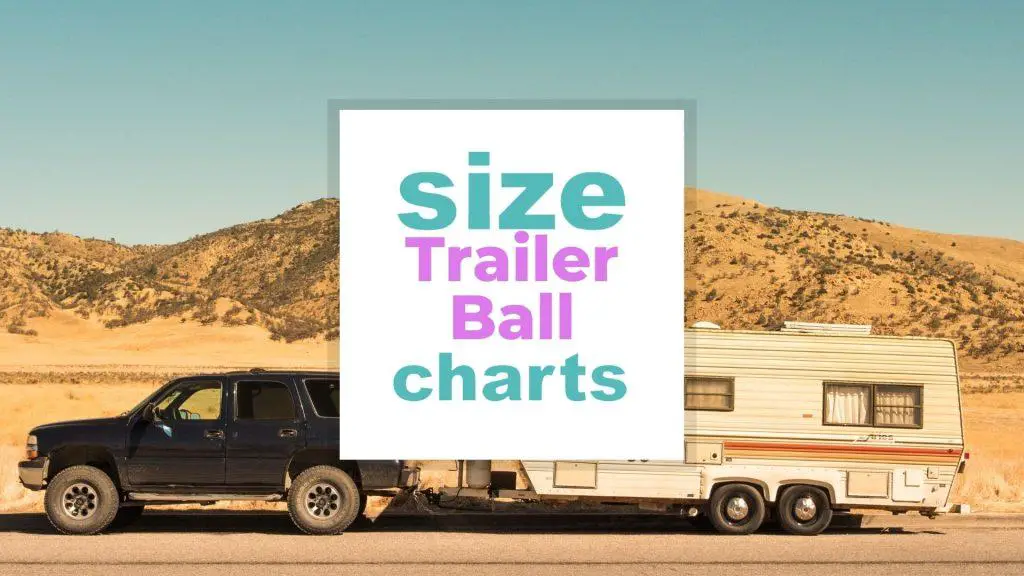
Are you the usual camping family, planning on how to travel with your recreational tow vehicle (RV) during the summer. You will definitely require a trailer. A trailer needs to have a ball which is dependent on the trailer size and trailer weight limit. You can immediately jump to the frequently asked questions
Stay tuned as we continue !

Table of Content of Trailer Ball Sizes
Trailer ball diameter chart, trailer ball hitch size and towing capacity chart.
- Detailed Trailer Ball Hitch Size Chart
Trailer Ball Size for Towing Chart
Axle ratio and safe towing weight chart, trailer weight chart.
In the table below you find the trailer ball diameter chart showing the ball tow capacity in pounds and kilograms, ball diameter in inches and cm, rise in inches and cm, threads per inch, shank diameter, and length in inches and cm. All about trailer sizes you can read here or RV size by model you find here
The hitch ball diameter is crucial in determining the towing capacity, for example, light-duty towing and heavy-duty towing require a 1.875-inch and 2.3125-inch trailer hitch ball respectively.
Hitch Ball / Bolt Diameter and Towing Capacity Chart
Here we have a table showing the ball size in inches and its equivalent bolt diameter in inches and cm and the capacity in pounds and kilograms.

Detailed Trailer Ball Hitch Size Chart.
Having a detailed trailer ball hitch size chart is just great. The size chart has the class, basic use, size of the opening in inches and cm, gross trailer weight, and tongue weight in pounds and kilograms.
In the table below we have the trailer hitch class and the equivalent towing capacity in pounds and kilograms. Each class has the compatible vehicles vividly shown in the trailer ball size for towing chart.
In the chart below, we have the axle ratio, maximum trailer, and gross combination weight ratio in (pounds and kilograms) for each type of vehicle for safe towing.
In the table below you will find the utility trailer, single axle, and tandem axle trailer types.
Frequently Asked Questions
How to choose a ball mount and trailer ball size, what is the most popular size of a trailer ball for a trailer hitch.
The 2-inch ball size is the standard size that is mounted on most vehicles’ hitch assembly. This is mainly due to its ability to match up to the 2-inch hitch receiver which is again the most common size among the variety of sizes of trailer hitch receivers available in the market. The 2 5/6 inches, the 1 7/8 inches, and the 3 inches diameter sized trailer hitch balls are other less common but also available options of trailer hitch balls.
How many trailer hitch ball sizes exist in the market?
There are about four different sizes of trailer hitch balls that are readily available in commercial hitch ball sellers. The 1 7/8 inches tow ball, 2 5/6 inches ball hitch, 2-inch ball size, and the 3-inch ball hitch which is commonly used in the gooseneck mount for the 5th wheel gooseneck hitch. Light duty trailers are towed by the 1 7/8 inches tow ball, medium load trailers are towed using the 2 inches trailer hitch ball, while the heavy trailers are towed with the 1 7/8 inches trailer ball hitch
Should the ball hitch size and the coupler size always match?
The ball hitch and the coupler size should always match to avoid any kind of play between the two. A mismatch between the trailer ball hitch size and the coupler size can lead to an accident in case of a disconnection.
Which trailer ball size is the most versatile?
The 2-inch hitch ball size is the standard ball size for its versatility in load handling that ranges from 1587.5 kg loads to 5443.1 kg load as the gross trailer weight. the 2-inches ball hitch diameter is also found as part of other popular hitch mounts, among them includes the camper, the utility trailers, the 5th wheel, and other typical tow vehicles.
How do you determine the trailer hitch ball size?
Where the diameter of the hitch ball sphere is not marked on top of the ball, you can always use the usual measuring tools available to you whether it is a ruler or a tape measure or even if it is calipers, any of these tools should give you the precise ball measurement. Other measurements like the hitch ball shank diameter, trailer ball hole diameter, base thickness, number of threads on the threaded stem shank can also be measured to ensure the components match as required and that there will be a safe connection before towing any load.
Which among the trailer hitch balls is the smallest?
The trailer hitch ball that can be ranked as the smallest for towing lightweight load class in tow ratings is the 1-7/8” tow ball. This tow ball size fits with the 1-7/8” coupler that has a load capacity of between 2000 lbs and 3500 lbs gross trailer loads.
What trailer hitch ball size would be recommended for my trailer?
The recommended trailer hitch ball size is always the one that would match the size of its coupler. The coupler size or measurement should be clearly indicated on the coupler or can be measured directly with a ruler or tape measure. The coupler size determines the hitch ball size since the two measurements should always be the same.
Trailer Ball sizes explained (tutorial)
For safe and efficient towing whereby there will not be a vehicle and trailer disconnect and also no damage to the vehicle brake pads or general brake failure due to excess towing weight, it is good to ensure that the rating of the towing set up and the vehicle towing capacity do match. This information can also be found on vehicle towing charts or other media like the trailer life magazine. The trailer tongue weight should always be measured using any scale i.e household scale or bathroom scale placed on a box, or a built-in scale to make sure your vehicle is properly loaded before you begin towing. Ensure also that the safety chain, locking pin, and trailer brake lights are all secured and installed as required.
If you enjoyed reading this article please, don’t hesitate to leave a comment below.
Related trailer and car size charts

- Tires Charts
Egle Goleckyte 585 Posts
Leave a reply cancel reply.
Your email address will not be published. Required fields are marked *
Save my name, email, and website in this browser for the next time I comment.
Imagine a world with minimum to zero returns. Imagine a perfect fitting bought product. Our vision is to improve the online shopping experience by becoming the go-to source for accurate sizing tools and information, reducing returns, and increasing customer confidence and conversion rates.
Privacy Policy
The Partner network
Request or add a size chart
Wordpress plugin
Chat-GPT Size Advisory
Size Chart Search Engine
Size Charts by Brands
- Converse Size Charts
- Allbirds Size Charts
- Dr Martens Size Charts
- Hanks Size Charts
- Hermès Size Charts
- Veja Size Charts
- Lane Bryant Size Charts
- Diadora Size Charts
- Salvatore Ferragamo Size Chart
- Chanel Size Charts
- Levis Size chart
- Valentino Size Charts
- Moncler Size Charts
- Lee Size Charts
- Merrell Size Charts
- Diesel Size Charts
- Armani Size Charts
- Wrangler Size Charts
- Salomon Size Charts
- Miss Me Size Charts
Size Charts by Topics
- Insoles Size Chart
- Bookcase Size Charts
- Battery Size Chart
- Country size charts
- Bracelet Size Chart
- RV size Chart
- Rug Size chart
- Skateboard Size Chart
- Cap Size Chart
- Fitness Size Chart
- Music Size Chart
- Condom Size Chart
- Gun Size Chart
- Snow Size Chart
- Helmet Size Chart
- Diapers Size Charts
- Hats Size Chart
- Maternity Size Charts
- Gloves Size Chart
- Glasses Size Chart
Size Charts by Gender
- Men Size Charts
- Kids Size Charts
- Women Size Charts
Size Charts by Types
- Comfort Size Charts
- Dog Size Charts
- Fish Size Chart
- Gender Neutral Size Charts
- Golf Size Charts
- Horse Size Charts
- Luxury Size Charts
- Plus Size Charts
- Safety Size Charts
- Work Size Charts
The Enlightened Mindset
Exploring the World of Knowledge and Understanding
Welcome to the world's first fully AI generated website!
Choosing the Right Size Ball for Your Travel Trailer – A Guide
By Happy Sharer
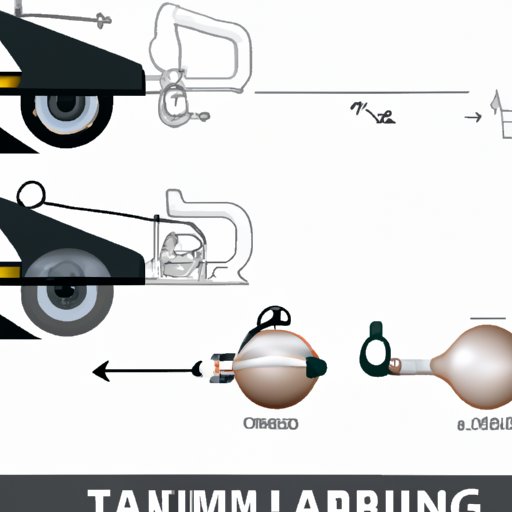
Introduction
When it comes to towing a travel trailer, having the right size ball is essential for ensuring safe and successful trips. But what exactly is a ball for a travel trailer and why is it important to choose the right size?
A ball for a travel trailer is a type of hitch that attaches to the tow vehicle and provides a connection point for the trailer. It is essentially a large steel ball mounted to a metal bracket. The ball’s size is determined by the weight capacity of the trailer and the type of vehicle being used to tow it. Choosing the right size ball for your travel trailer is important as it ensures increased stability while towing, improved performance and handling, and enhanced safety.
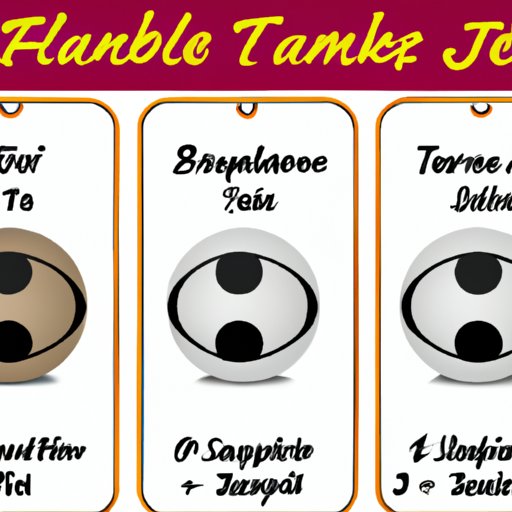
A Guide to Choosing the Right Size Ball for Your Travel Trailer
In order to select the optimal ball size for your travel trailer, there are a few steps you need to take. The following guide will provide you with all the information you need to choose the right size ball for your trailer.
How to Determine the Appropriate Ball Size for a Travel Trailer
The first step in determining the appropriate ball size for your travel trailer is to measure the tongue weight of your trailer. Tongue weight is the downward force exerted on the hitch by the trailer, which is typically between 8-15% of the trailer’s gross weight. Once you have determined the tongue weight, you can then determine the capacity of the hitch receiver.
The next step is to consider the type of vehicle you will be using to tow the trailer. This will help you decide if you need a Class I, II, III or IV hitch. Class I hitches are designed for light-duty vehicles such as small cars, while Class IV hitches are designed for heavy-duty vehicles such as pickup trucks.
What to Consider When Selecting the Optimal Ball Size for Your Travel Trailer
Once you have determined the capacity of the hitch receiver and the type of vehicle you will be using to tow your trailer, you can then consider the following factors when selecting the optimal ball size for your travel trailer:
- The weight of the trailer: Make sure the ball size you select is suitable for the tongue weight of your trailer.
- The type of trailer: Different types of trailers require different ball sizes. For example, a pop-up camper will require a smaller ball size than a fifth-wheel trailer.
- The type of vehicle: As mentioned earlier, the type of vehicle you use to tow the trailer will determine the type of hitch you need. This in turn will affect the size of the ball you need.
The Benefits of Having the Correct Ball Size for Your Travel Trailer
Having the correct ball size for your travel trailer is essential for ensuring your safety and comfort while towing. The following are some of the benefits of having the right size ball:
- Increased stability while towing: Having the right size ball helps to ensure that your trailer is securely attached to your tow vehicle, resulting in increased stability while towing.
- Improved performance and handling: With the right size ball, your trailer will be more responsive to steering, resulting in improved performance and handling.
- Enhanced safety: Having the right size ball means that the trailer is less likely to detach from the tow vehicle, which will help to keep you and other drivers on the road safe.
Exploring the Different Types of Balls Available for Travel Trailers
Now that you have a better understanding of how to choose the appropriate ball size for your travel trailer, let’s explore the different types of balls available:
Traditional Ball Mounts
Traditional ball mounts are the most common type of ball for travel trailers. They are simple and easy to use, and come in a variety of sizes to suit different weights and types of trailers. The main benefit of traditional ball mounts is that they are relatively inexpensive and easy to install.
Drop Hitches
Drop hitches are similar to traditional ball mounts but offer more flexibility. They allow you to adjust the height of the ball to match the tongue weight of your trailer, resulting in improved stability while towing. They are also more secure than traditional ball mounts, as they are bolted directly to the hitch receiver.
Pintle Hooks
Pintle hooks are an alternative to traditional ball mounts and drop hitches. They are designed for heavier trailers, such as those used for commercial purposes, and provide a more secure connection between the trailer and the tow vehicle. They are also much easier to install than traditional ball mounts or drop hitches.
Weight Distribution Systems
Weight distribution systems are designed to improve the handling and stability of your trailer while towing. They consist of a ball mount, a hitch receiver and a spring bar system which helps to distribute the weight of the trailer over the axle of the tow vehicle. These systems are ideal for larger trailers, as they provide increased stability while towing.
Choosing the right size ball for your travel trailer is essential for ensuring your safety and comfort while towing. By following the steps outlined in this guide, you can easily determine the appropriate ball size for your trailer and select the optimal ball size for your needs. Additionally, exploring the different types of balls available for travel trailers can help you find the best solution for your particular situation.
Having the correct size ball for your travel trailer is essential for improved safety, increased stability and better performance. This guide provides information on how to determine the appropriate ball size for a travel trailer, what to consider when selecting the optimal ball size and the different types of balls available.
Final Thoughts
Towing a travel trailer can be a rewarding experience, but it is important to ensure that your trailer is securely attached to your tow vehicle. By selecting the right size ball for your trailer, you can enjoy improved stability while towing, improved performance, and enhanced safety.
(Note: Is this article not meeting your expectations? Do you have knowledge or insights to share? Unlock new opportunities and expand your reach by joining our authors team. Click Registration to join us and share your expertise with our readers.)
Hi, I'm Happy Sharer and I love sharing interesting and useful knowledge with others. I have a passion for learning and enjoy explaining complex concepts in a simple way.
Related Post
Exploring japan: a comprehensive guide for your memorable journey, your ultimate guide to packing for a perfect trip to hawaii, the ultimate packing checklist: essentials for a week-long work trip, leave a reply cancel reply.
Your email address will not be published. Required fields are marked *
Expert Guide: Removing Gel Nail Polish at Home Safely
Trading crypto in bull and bear markets: a comprehensive examination of the differences, making croatia travel arrangements, make their day extra special: celebrate with a customized cake.

- Remember me Not recommended on shared computers
Forgot your password?
- Mechanical & Technical Tips
Ball size for hitch
By Margaret July 16, 2022 in Mechanical & Technical Tips
Recommended Posts
I have a question about ball size. Does the ball on the receiver hitch have to be 2 inches or can it be 2 and 5/16th of an inch?
Thank you!!!
Margaret. Oliver Legacy Elite II, 2017 (Jasmine). Nissan Armada 2018. Hull 179.
Link to comment
Share on other sites.

Did you mean 1 7/8 " ?
24 minutes ago, wyodoc86 said: Did you mean 1 7/8 " ?
Hi Wyodoc, No, actually, I meant 2 5/16". Oops. Thanks! I will edit.

Just now, Margaret said: Hi Wyodoc, No, actually, I meant 2 5/16". Oops. Thanks!
It can be a 2-5/16” ball only if your Bulldog hitch has been upgraded from 2”.

Steve, Tali and our dog Rocky plus our beloved Storm, Maggie, Lucy and Reacher (all waiting at the Rainbow Bridge)
2008 Legacy Elite I - Outlaw Oliver, Hull # 026 | 2014 Legacy Elite II - Outlaw Oliver, Hull # 050 | 2022 Silverado High Country 3500HD SRW Diesel 4x4

John E Davies
The ball has to match the size stamped in the Bulldog coupler. The normal one used is 2”, but Oliver has been installing some larger customer supplied 2 5/16” couplers prior to delivery. Yours is probably 2” but you should visually verify.
Welcome to the forum.
John Davies
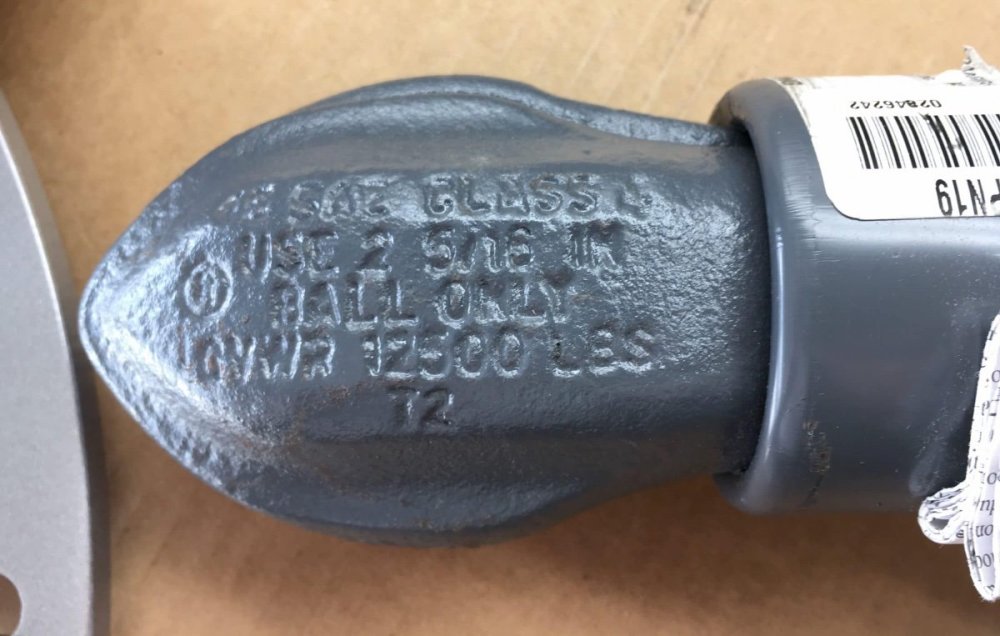
SOLD 07/23 "Mouse": 2017 Legacy Elite II Two Beds, Hull Number 218, See my HOW TO threads: https://olivertraveltrailers.com/topic/john-e-davies-how-to-threads-and-tech-articles-links/
Tow Vehicle: 2013 Land Cruiser 200, 32” LT tires, airbags, Safari snorkel, Maggiolina Grand Tour 360 Carbon RTT.

Mike and Carol
If you have the standard Bulldog it is a 2”. A 2 5/16” would be too big. Mike
Texas Hill Country | 2016 Elite II #135 | 2020 Ram 2500 6.7L

AlbertNTerri
Oliver supplied the 2 5/16 coupler we had installed on our build. They charged me something like $250 to make it happen...I just had to ask for it. One of the few custom upgrades still available.
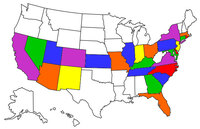
Albert & Terri Sterns
Paonia, Colorado
Elite II Hull #1125 Standard Floorplan / 2017 Ford F250 gas

Has anyone had a problem or failure with the 2" hitch? I see posts on upgrading, but I've not seen a solid reason to do it.
2021 Elite II Twin #850 "Mojo", 2020 F250 Lariat 7.3L FX4 3.55
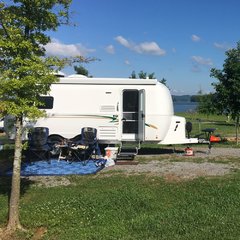
1 hour ago, MobileJoy said: Has anyone had a problem or failure with the 2" hitch? I see posts on upgrading, but I've not seen a solid reason to do it.
I’ve never heard of any failures of the Bulldog 2” coupler on an Oliver trailer. But some owners upgrade to get a bigger safety margin on the weight rating. The 2” Bulldog is rated at 7,000 lbs., same as the Oliver Elite II GVWR (Gross Vehicle Weight Rating) of 7,000 lbs. The 2-5/16” Bulldog is rated at 12,500 lbs. but there are other critical parts of the trailer such as the axles that are a limiting factor as well for the GVWR. The Dexter axles used on the Elite II are rated at 3,500 lbs. per axle (see photo of the axle label below), so two axles gives a weight limit of 7,000 lbs. for the trailer. Some owners that travel very heavily loaded have also upgraded the axles on their Oliver along with upgrading the Bulldog coupler.
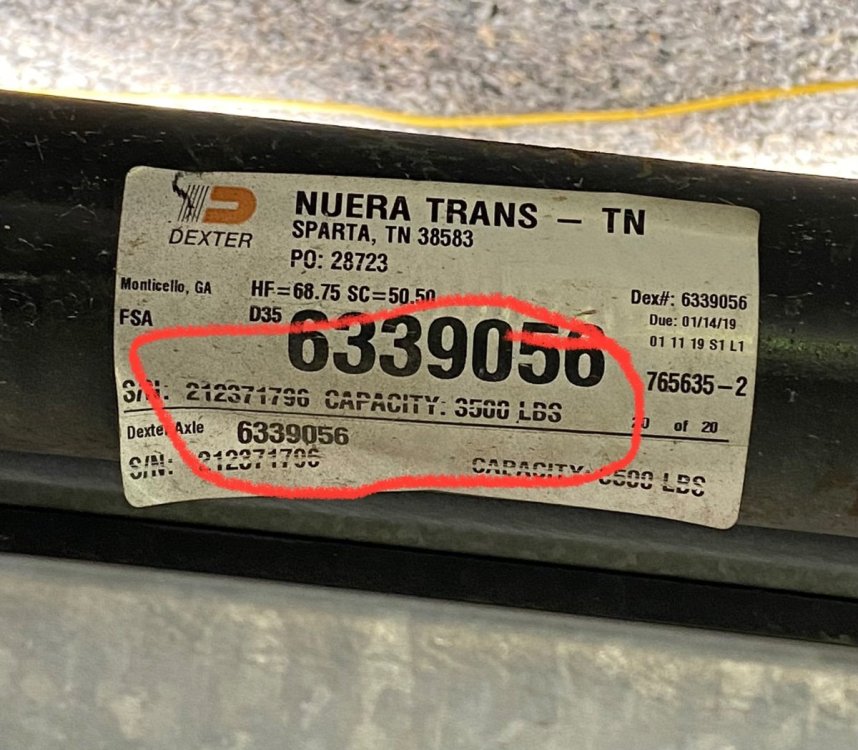
I've never seen an Oliver with the 2 5/16" upgrade coupler and ball when seeing other Oliver's when camping. For me personally I would stick with the 2" setup and the extra load ratings would not be needed for me, but if I have a 2 5/16" setup on my 3/4/1ton truck I go with the 2 5/16" setup for convenience. There is no end to upgrades for these trailers, so if it works for you, then do it.
2019 RAM 1500, 5.7 Hemi, 4X4, Crew Cab, 5'7" bed, Towing Package, 3.92 Gears.
The wear on the Andersen hitch ball may be significantly reduced; it depends on how well the under side of the coupler was manufactured, and how tight the chains are adjusted…. My 2” Bulldog was pretty rough, and even the brand new replacement had blobs of weld splatter too!
I towed “Mouse” about 5000 miles with a dead weight hitch behind a HD Ram and the 2” ball still looked OK. I switched TVs and installed an Andersen setup.
My small Andersen ball was pretty much wrecked (and the very deep groove occasionally locked up and made a loud banging noise) after just a thousand miles. After installing the large ball and coupler it took about 18,000 before I started seeing similar wear. The ball does indeed need to be lubricated, even though it is advertised as grease free, or you will end up with a rusty mess. Plus the larger safety margin makes sense to me. I don’t overload but do tow on rough back roads. Even if I had a dead weight hitch the bigger ball would make me worry less about something happening in the boonies.
A replacement Andersen ball and friction sleeve retails for about $80. The coupler itself is less than $100. Plus labor charges if you are not comfortable going the job. So $250 installed by Oliver seems fair to me, IF they give you back your smaller unused parts to resell!
https://olivertraveltrailers.com/forums/topic/2139-bulldog-coupler-destroys-anderson-ball/

4 hours ago, AlbertNTerri said: One of the few custom upgrades still available.
I have a silly question concerning which department installed your 2 5/16" Bulldog coupler. If the 2 5/16" coupler was installed in the production department, I would consider that an upgrade. If it was installed in the service department, I would consider that a modification. In the past, the Oliver production department would not install the Bulldog 2 5/16 coupler as an upgrade when building a trailer. That modification was completed in the service department. The reason I point this out is because there have been complaints on this forum about Oliver’s production policy of no longer allowing custom upgrade’s as they did in the early days. And when I read your post above, I thought it might set an unrealistic expectation for someone thinking of ordering an Oliver. So can you clarify which department installed your coupler?
Mike and Krunch Lutz, FL 2017 LEII #193 “the dog house”

snakeriveridaho
30 minutes ago, mossemi said: the 2 5/16" coupler was installed in the production department, I would consider that an upgrade.
FYI, The 2 5/16 coupler is now listed as on option on the 2023 build sheet.
Kirk and Carrie Peterson
Twin Falls, Idaho
2018 Ram 3500, with overland conversion: Rooftop tent, water, stove, Battle Born batteries, lockers, onboard air, raised air intake, Warn winch.
2023 Elite 2, twin beds, delivered December 5, 2022 Truma package, lithium platinum package. Hull #1305
52 minutes ago, Kirk Peterson said: The 2 5/16 coupler is now listed as on option on the 2023 build sheet.
Thanks, what is the cost? Do they charge anything extra for the matching Andersen?
And it is about time! Where is that disk brake option? 😀
Can you scan that build sheet and post it?
1 hour ago, Kirk Peterson said: FYI, The 2 5/16 coupler is now listed as on option on the 2023 build sheet.
Thanks Kirk! I guess I would have known that if I was shopping for a new Ollie. I am naturally attracted to shiny objects, so I try to avoid looking at sales brochures. 🙈 Do you know if that was an option in before 2023?
DaveAndBecky_NorthernMI
For what it's worth, I have towed approximately 4500 miles with my trailer. I noticed a "gravelly" rattle noise develop recently. I replaced my receiver and ball and the noise went away. I see some wear on the replace 2" ball from Bulldog. I do not have Anderson as my tow vehicle does not recommend weight distribution hitches.
2022 Oliver Elite II Hull#1047 "Saunter"
2014 VW Touareg TDI
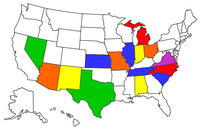
59 minutes ago, John E Davies said: Thanks, what is the cost? Do they charge anything extra for the matching Andersen? And it is about time! Where is that disk brake option?
The cost for the 2 5/16 bullbog coupler is $300.
2 inch Andersen no-sway is $850
2 5/16 Andersen no sway with 2 5/16 bulldog coupler is $1200
From OTT for 2023 E2:
46 minutes ago, mossemi said: Do you know if that was an option in before 2023?
The 2-5/16 Bulldog coupler was not on the build sheet for the 2022 E2. You had to know about it and ask for it.

On 7/16/2022 at 2:14 PM, ScubaRx said: It can be a 2-5/16” ball only if your Bulldog hitch has been upgraded from 2”.
Thank you, Scuba!
On 7/16/2022 at 2:14 PM, John E Davies said: The ball has to match the size stamped in the Bulldog coupler. The normal one used is 2”, but Oliver has been installing some larger customer supplied 2 5/16” couplers prior to delivery. Yours is probably 2” but you should visually verify. Welcome to the forum. John Davies Spokane WA
Very useful, John, thank you!
9 hours ago, Kirk Peterson said:
Ok, that makes sense! Thank you , Kirk!
Great info, thanks!
12 hours ago, Kirk Peterson said:
Thanks for posting, I haven’t done it yet, but if you check all the expensive options, what is the total price for a fully specced out LE2? Mine was “moderately” equipped five years ago for $62k 😳
Create an account or sign in to comment
You need to be a member in order to leave a comment
Create an account
Sign up for a new account in our community. It's easy!
Already have an account? Sign in here.
- Existing user? Sign In
- All Activity
- Leaderboard
- Online Users
- Travel Trailers
- Campers for Sale
- Create New...

IMAGES
VIDEO
COMMENTS
This type of towing hitch isn't typically used for hauling fifth-wheel RVs. For most RVers, the standard travel trailer hitch ball size will be 2" or 2-5/16". Smaller travel trailers will usually use a 2" ball, while heavier trailers will need the 2-5/16" ball. Besides the diameter of the hitch ball, there are some other measurements ...
The hitch ball used to tow most travel trailers is a 2-inch or 2-5/16-inch trailer ball. Travel trailers can weigh anywhere from 5,000 to 10,000 lbs. or more, and the 2-inch to 2-5/16-inch ball weight ratings provide a perfect match. ... The standard ball size for a trailer hitch is 2 inches in diameter. Most trailers have a 2-inch coupler ...
So, what are the most common travel trailer ball sizes? Almost all travel trailer hitches require a 2 and 5/16″ ball size to support the weight of the larger trailers. Smaller 2″ balls are common in teardrop trailers because of their lower weight rating. ... There are three types of trailer balls purchase options: Standard Ball; Switch ...
Stepping up to the 2-inch hitch ball drastically improves the weight rating from 3,500 to 12,000 pounds. This is the most common diameter for most medium-weight trailer hitch balls. You can expect to tow beefier loads, like medium-sized trailers. This includes campers, enclosed cargo trailers, and small to medium-sized boats.
The most popular trailer hitch ball size includes: 1-7/8-inch hitch size ball: The 1-7/8-inch hitch ball is used for towing lightweight travel trailers weighing under 3,600 lbs. Other smaller RV travel trailers can work perfectly with this size, but most trailers weigh above 3,600 lb. and will not work with this size.
1 ⅞" Ball. This ball size is typically not suited for towing a travel trailer or tent trailer. A 1 7/8″ ball has a capacity up to 2,000 pounds, therefore, it is not suited for towing travel trailers, but will work for a small utility trailer. These can be purchased in two different shank sizes of 3/4″ and 1″.
Standard Trailer Hitch Ball Sizes. Standard trailer hitch ball sizes refer to the common ball diameter sizes used in trailer hitches, which are usually either 1-7/8″, 2″, or 2-5/16″. The 1-7/8″ ball size is commonly used for light-duty towing, such as small utility trailers or pop-up campers that have a weight capacity of up to 2,000 ...
Typical tow vehicles: full-size cars, large SUVs, minivans, and trucks. An adapter allows you to mount hitch accessories made for a 1¼" receiver in a 2" hitch. The available range of capacities for Class III hitches varies quite a bit—from 3,500-8,000 lbs GTW and 350-800 lbs TW. Be sure to choose a ball mount with sufficient capacity to ...
The Most Common Ball Hitch Size for Travel Trailers. The hitch ball used to tow most travel trailers is a 2-inch or 2-5/16-inch trailer ball. Travel trailers can weigh anywhere from 5,000 to 10,000 lbs or more. The 2-inch to 2-5/16-inch ball weight ratings provide a perfect match.
Most Common Travel Trailer Ball Hitch Sizes. 2-Inch Ball: This size is suitable for lightweight and smaller travel trailers, often with a gross trailer weight (GTW) of 3,500 pounds or less. 2-5/16-Inch Ball: The 2-5/16-inch ball is the most common size, typically used for medium to large travel trailers with GTWs ranging from 3,500 to 25,000 ...
Standard Trailer Ball Sizes. There are four standard trailer ball sizes: 1-7/8″, 2″, 2-5/16″, and 3″. A trailer hitch ball's "size" is the measurement of the ball's diameter. Tow balls come in standard sizes to make them easy to match up to trailer couplers. As the ball size increases, so does the weight capacity it can handle.
The 2-inch diameter ball hitch is rated to carry 3,500 to 12,000 pounds. The 2-inch ball hitch is the most common ball hitch diameter. You would use the 2-inch ball hitch to pull a medium-sized trailer. CURT 45134 Fusion Trailer Hitch Mount with 2-Inch Ball & Pin, Fits 2-In Receiver, 7,500 lbs, 2" Drop , black.
The most commonly used hitch ball size is a 2-inch diameter ball. You'll find these regularly used on campers, utility trailers, and boat trailers. A 2-inch hitch ball or trailer ball can have a weight capacity of anywhere from 3,500 pounds to 12,000 pounds, so they're found on a wide variety of campers and trailers.
The three most common hitch ball sizes are 1-7/8", 2", and 2-5/16" in diameter. In rare cases, you'll find a 3" size. Hitch balls also have variations in size for shank diameter and shank length. The different sizes factor into the weight capacity of a towing system. Each trailer hitch ball will also need its matching hitch ball mount.
The rating of the hitch ball is just as important as the receiver hitch ratings. Ball Diameter (A): Check the top of the trailer coupler for the size of the ball diameter required. The size is usually stamped there. Recreational and light commercial hitch balls come in a variety of sizes including 1-7/8″, 2″, 2-5/16″ and occasionaly 3″.
The size of the hitch ball is crucial, as it determines the weight capacity of the trailer that it can tow. Standard Hitch Ball Sizes. There are three standard hitch ball sizes available, and they are 1 7/8 inches, 2 inches, and 2 5/16 inches. The 1 7/8 inch hitch ball size is suitable for small trailers weighing up to 2,000 pounds.
The 2-inch hitch ball size is the standard ball size for its versatility in load handling that ranges from 1587.5 kg loads to 5443.1 kg load as the gross trailer weight. the 2-inches ball hitch diameter is also found as part of other popular hitch mounts, among them includes the camper, the utility trailers, the 5th wheel, and other typical tow ...
Each is available in various standard sizes, so for instance, if you need to choose the proper tow ball for your trailer and application, you have the option to do just that. Three main finishes come on hitch balls: stainless steel, zinc-coated, and a powder-coated finish. Each of these is great for various reasons; for example:
This type of hitch can be used for a trailer 3,500 pounds or less — like a folding tent camper. Class 3: This hitch is for vans, pickup trucks, or even mid-size SUVs. 6,000 pounds is the max it can tow, and it would be right for lightweight travel trailers or mini travel trailers like a Wolf Pup. Class 4: Class 4 hitches are used for vehicles ...
The first step in determining the appropriate ball size for your travel trailer is to measure the tongue weight of your trailer. Tongue weight is the downward force exerted on the hitch by the trailer, which is typically between 8-15% of the trailer's gross weight. Once you have determined the tongue weight, you can then determine the ...
The 3″ hitch ball is not as commonly used as the other sizes but comes into play for extreme heavy-duty towing.. These might be paired with commercial equipment trailers, large fifth-wheel campers, or horse and livestock trailers.The 3″ hitch ball can handle substantial weight, typically with GTWs ranging from 21,000 - 30,000 lbs.. Installing the correct hitch ball is essential for safe ...
Honestly, it's less complicated. All U-Haul trailers use a 1-7/8″ or 2″ ball. Because of this, you only need to pay attention to weight capacity. Smaller options, like the 4×7 Utility Trailer, require a 2,000-pound rated ball and the Auto Transport will require, at minimum, a 5,000-pound capacity ball. But depending on the total combined ...
Author. Posted July 19, 2022. On 7/16/2022 at 1:14 PM, John E Davies said: The ball has to match the size stamped in the Bulldog coupler. The normal one used is 2", but Oliver has been installing some larger customer supplied 2 5/16" couplers prior to delivery. Yours is probably 2" but you should visually verify.